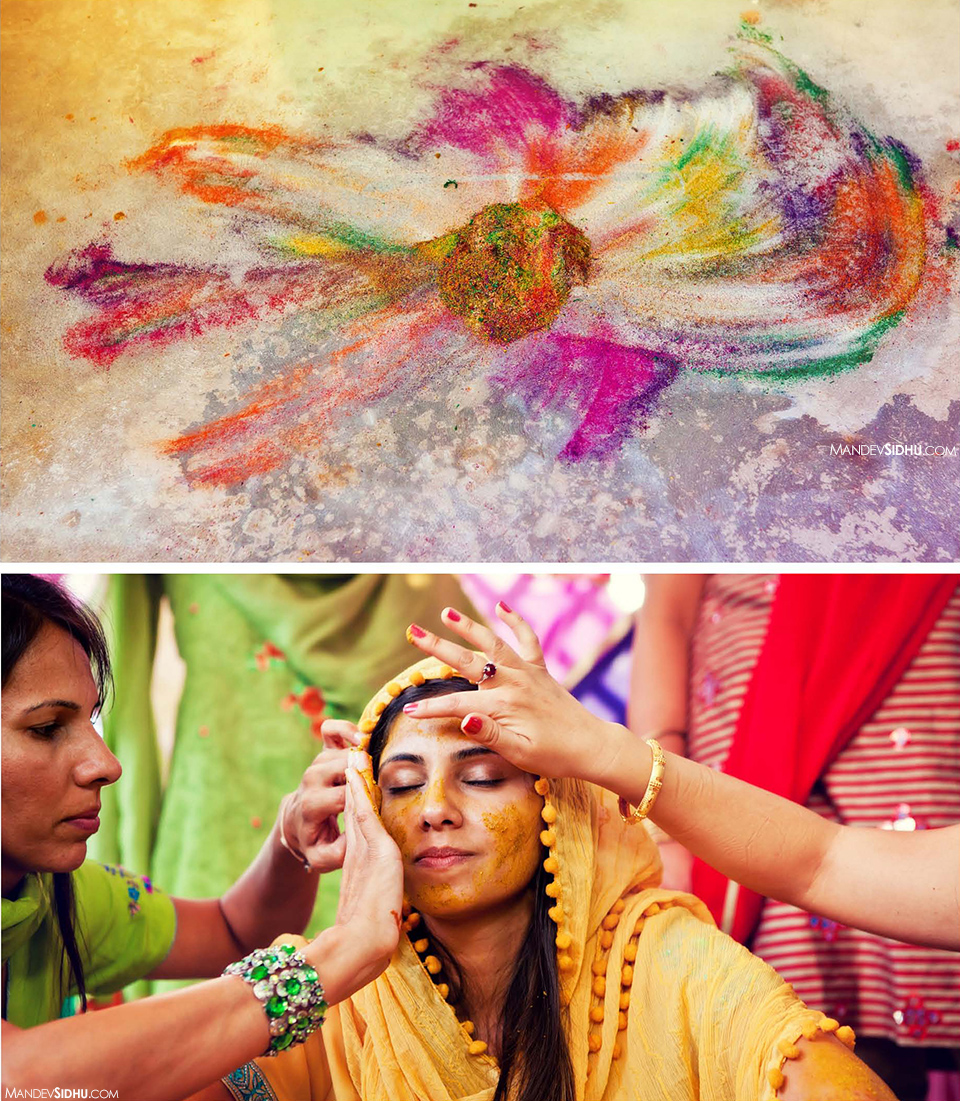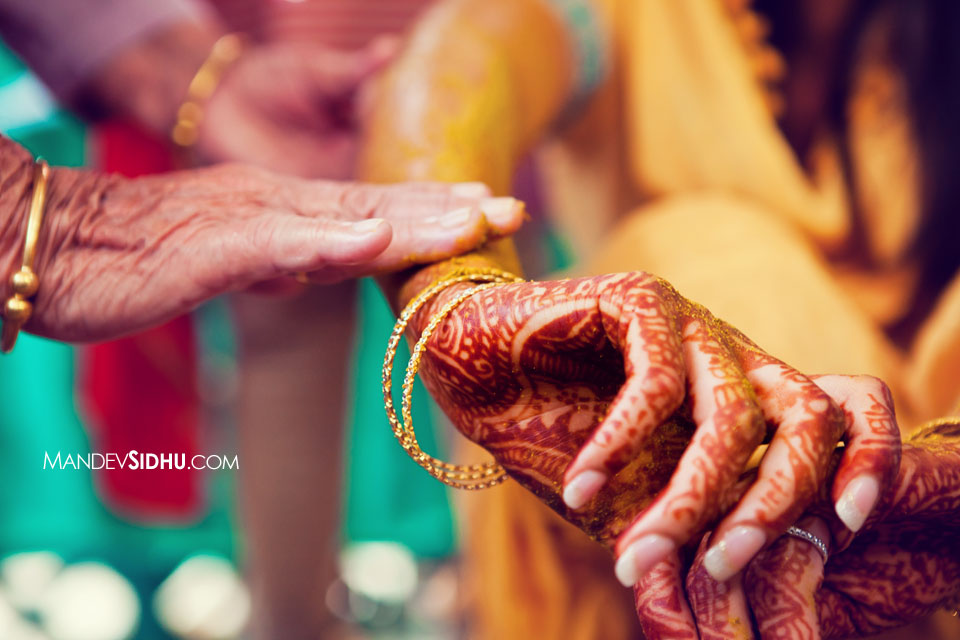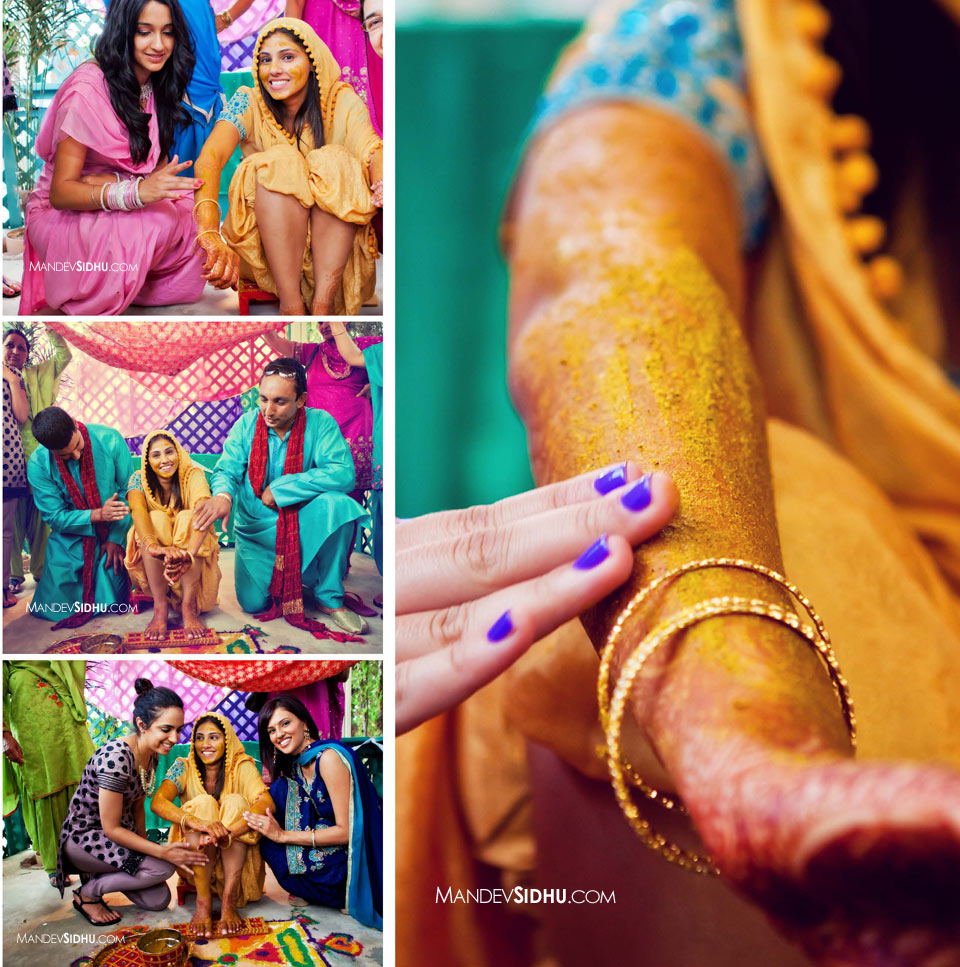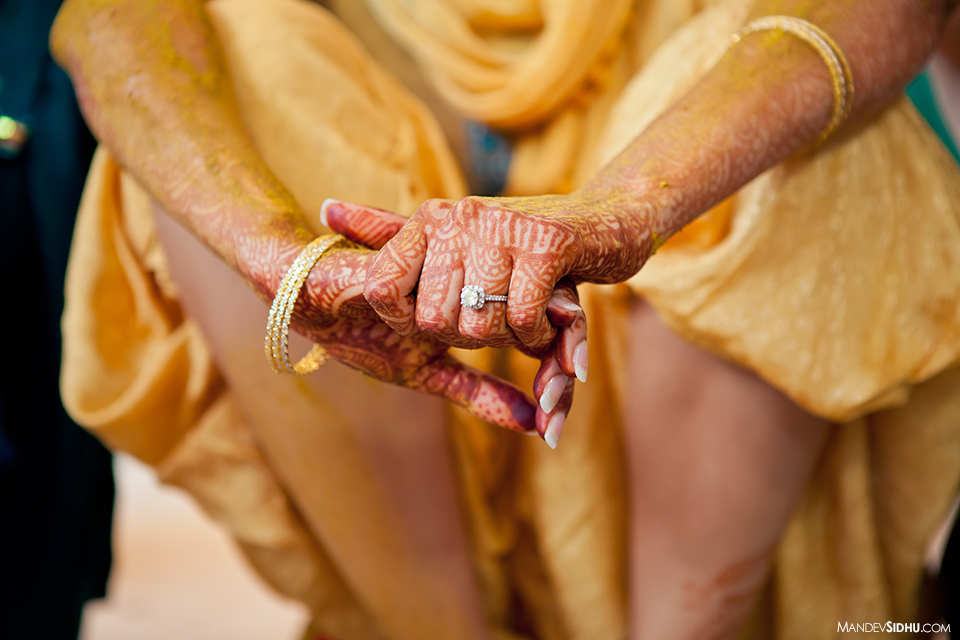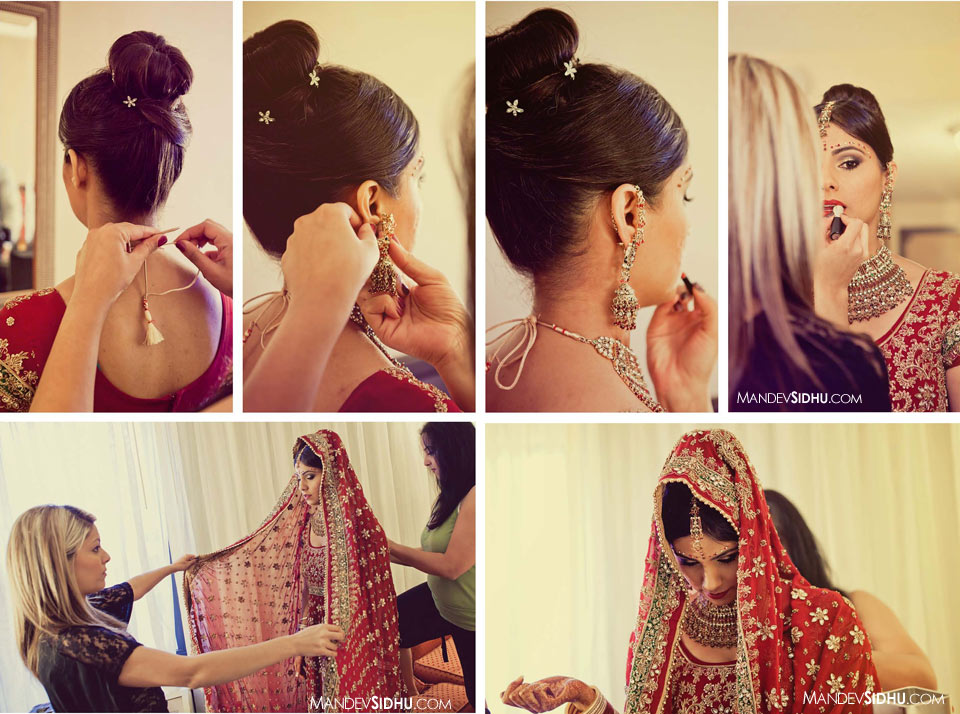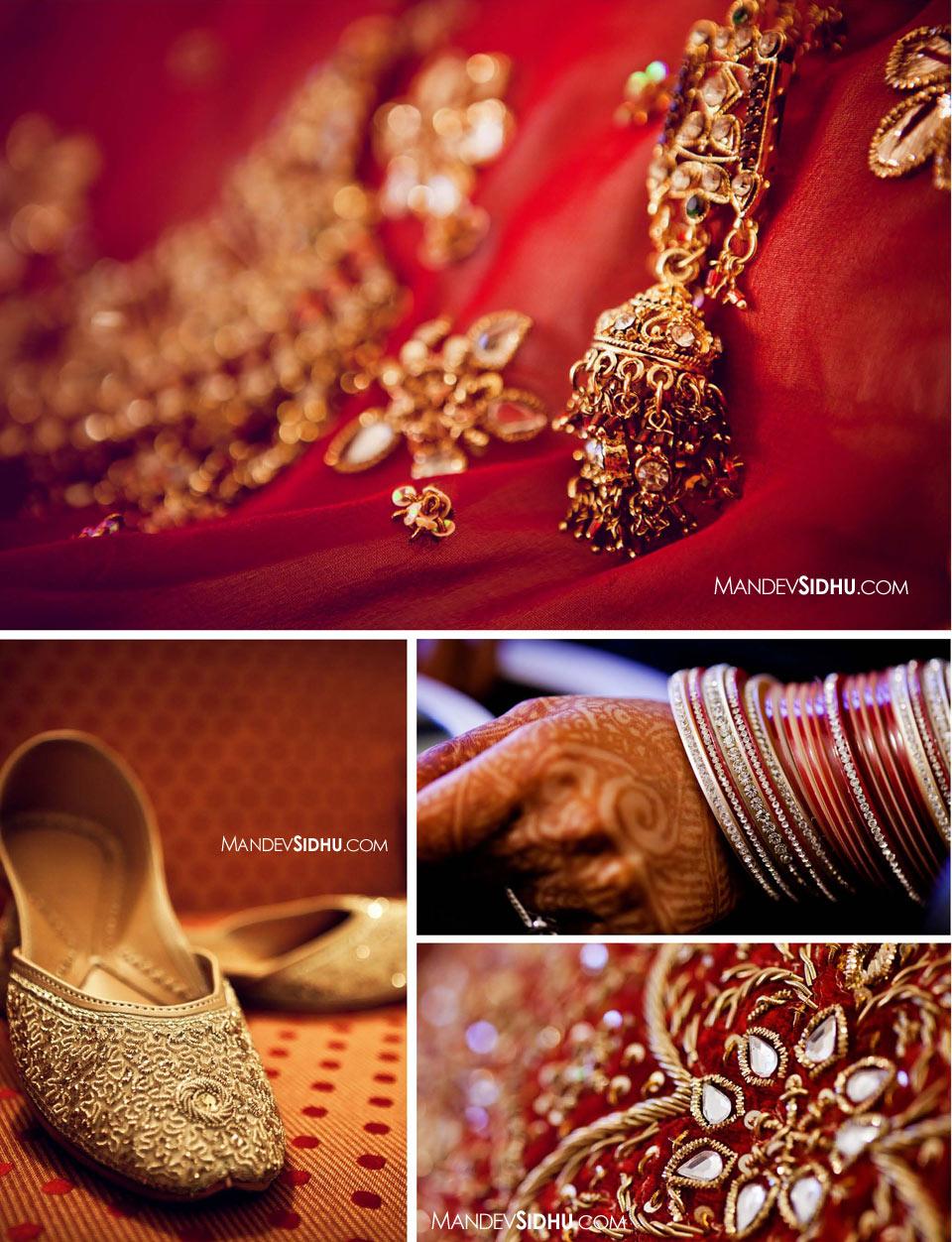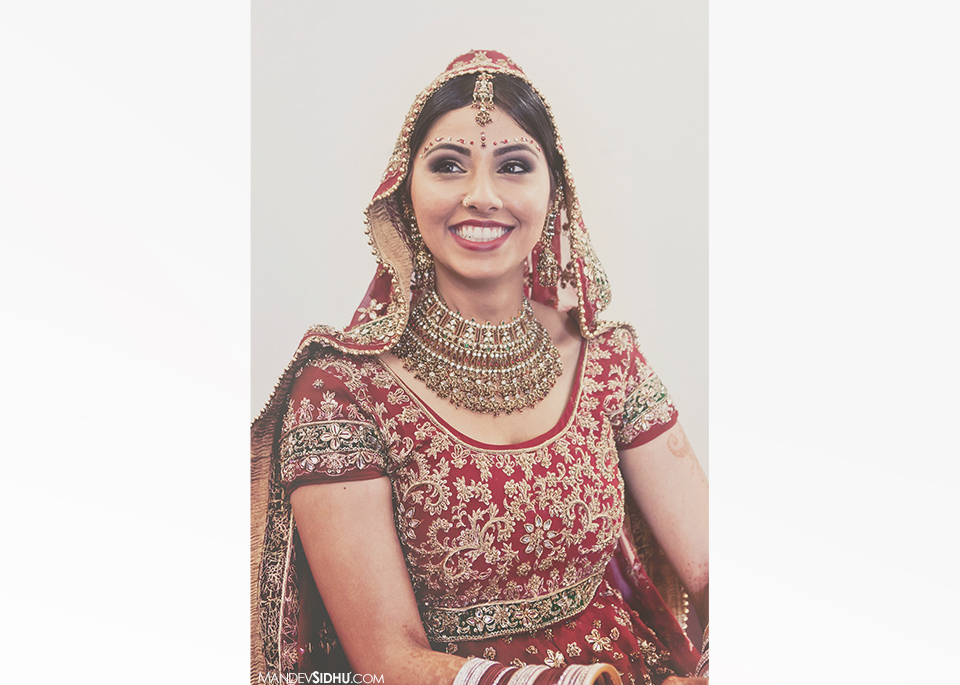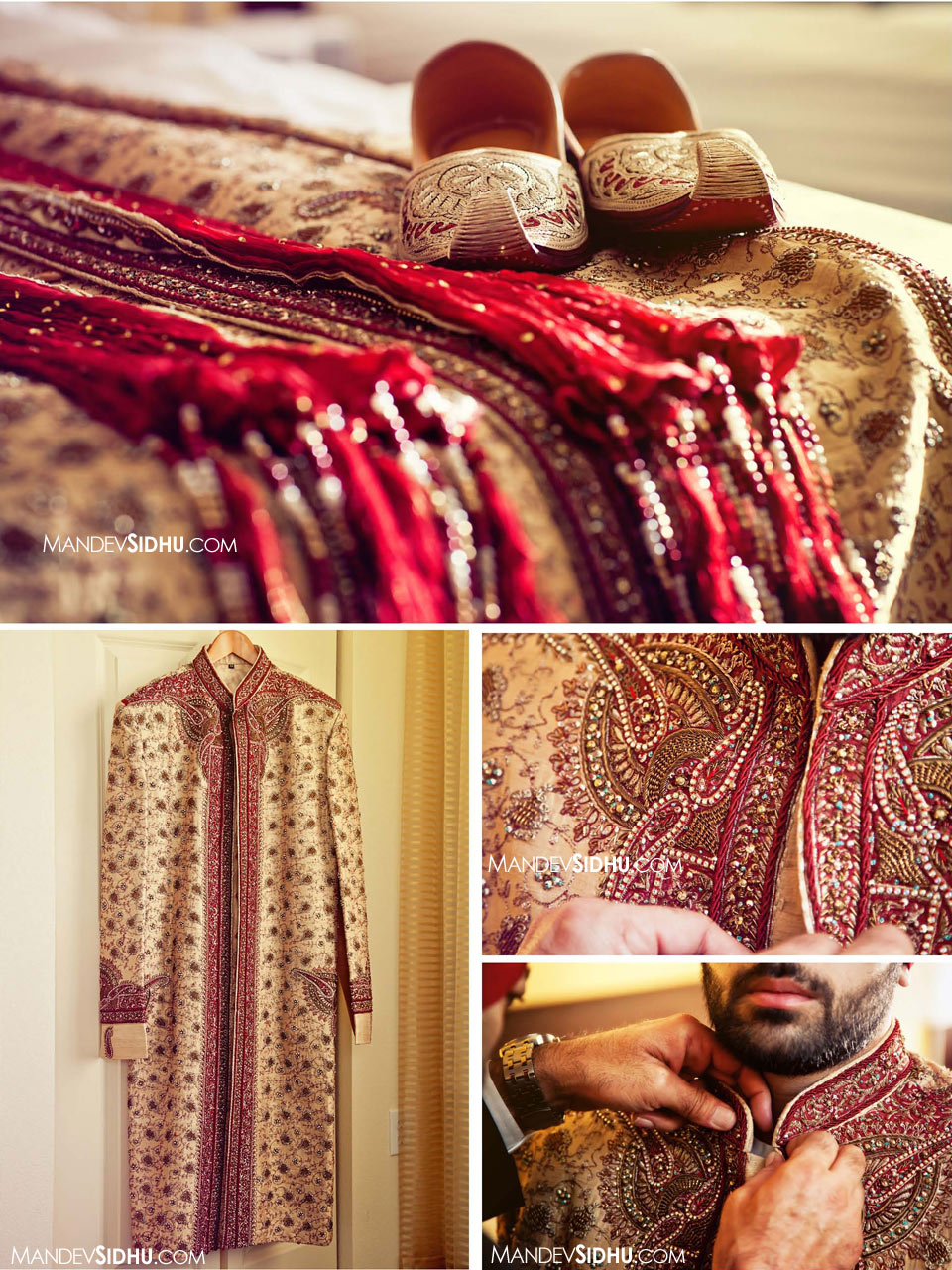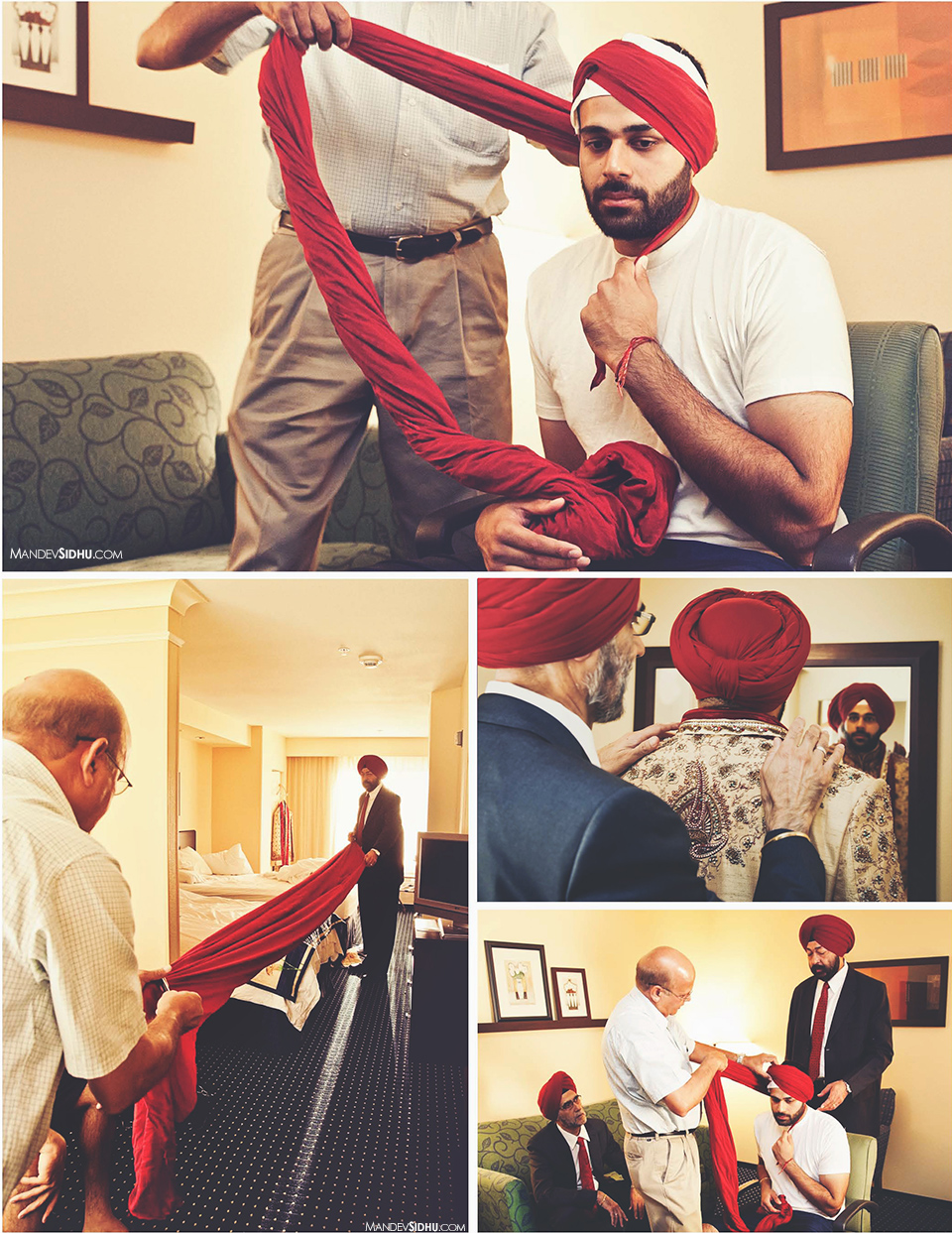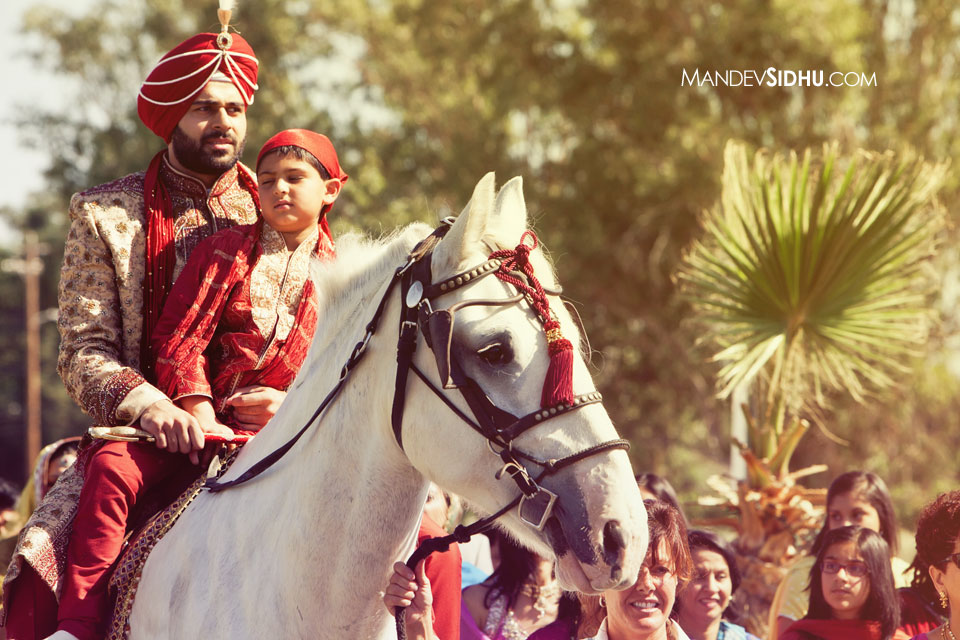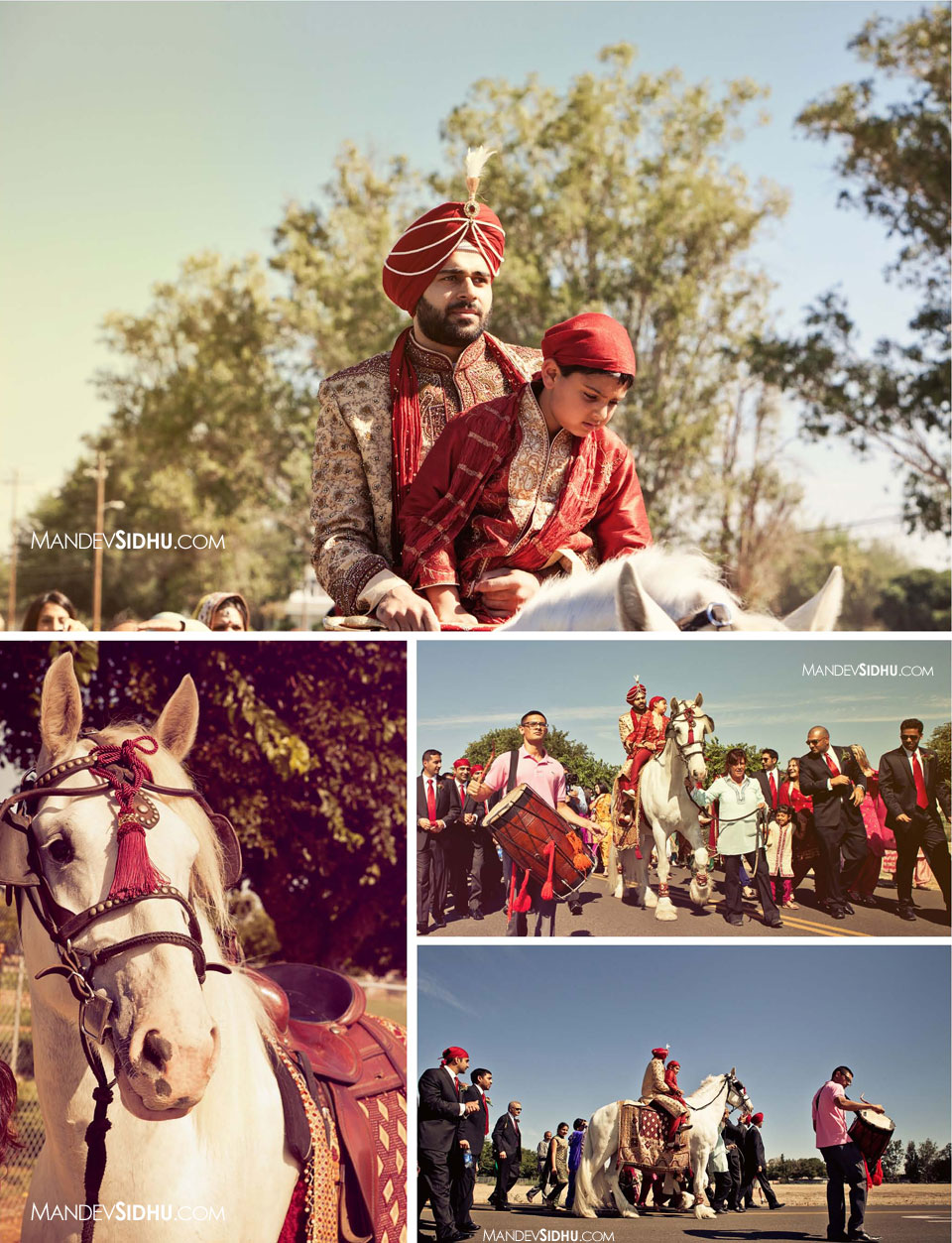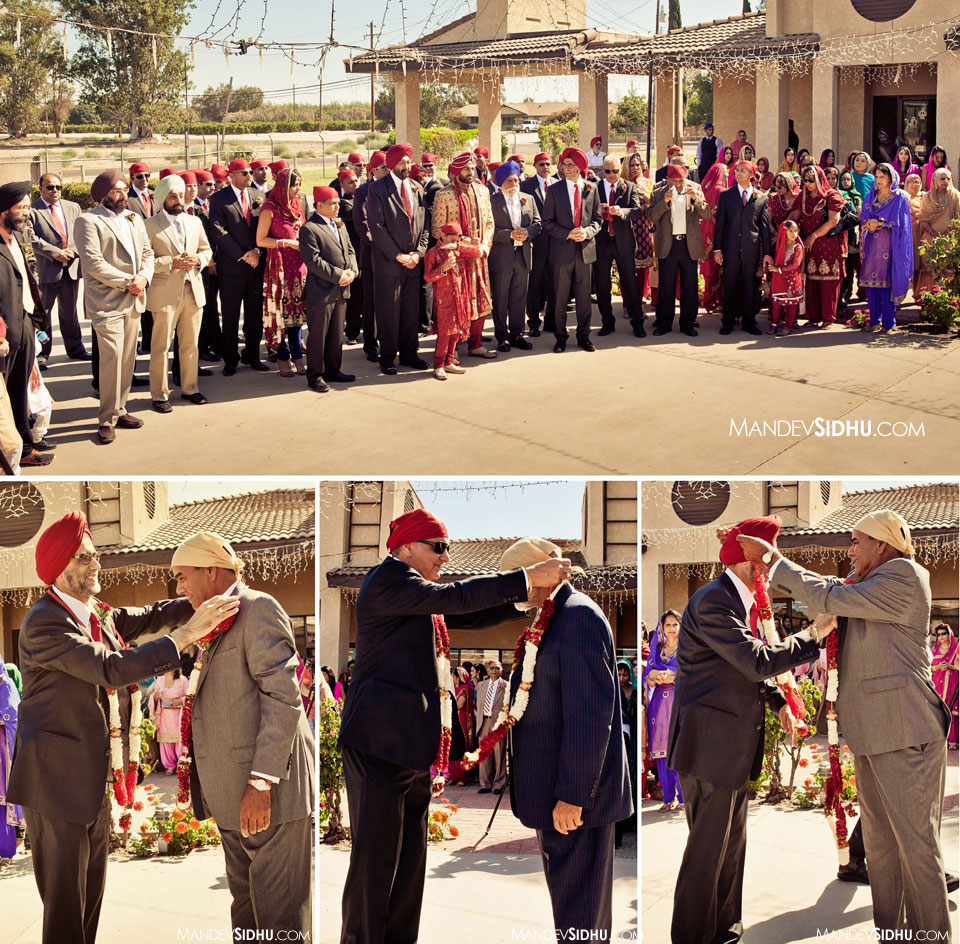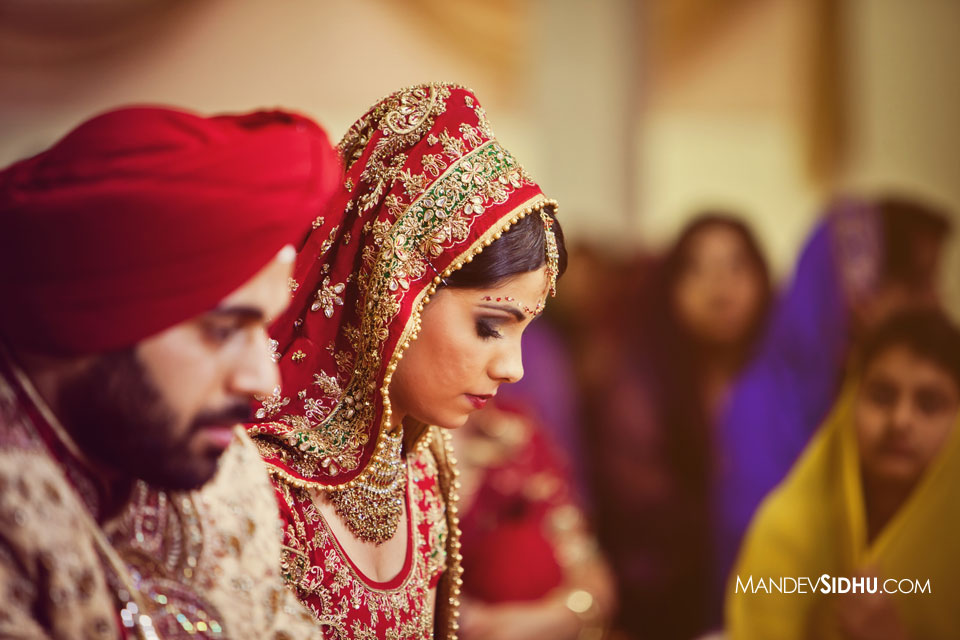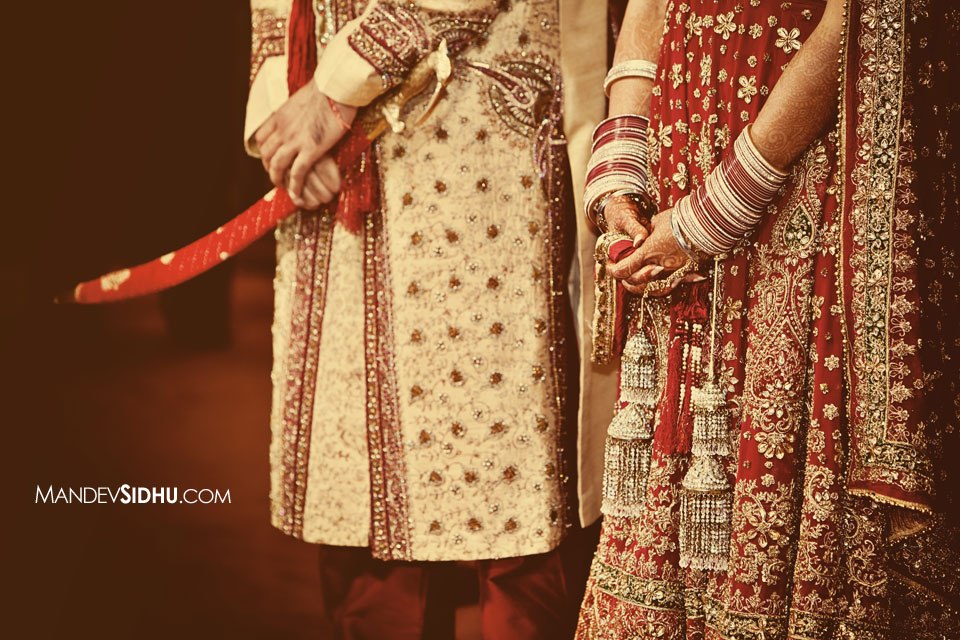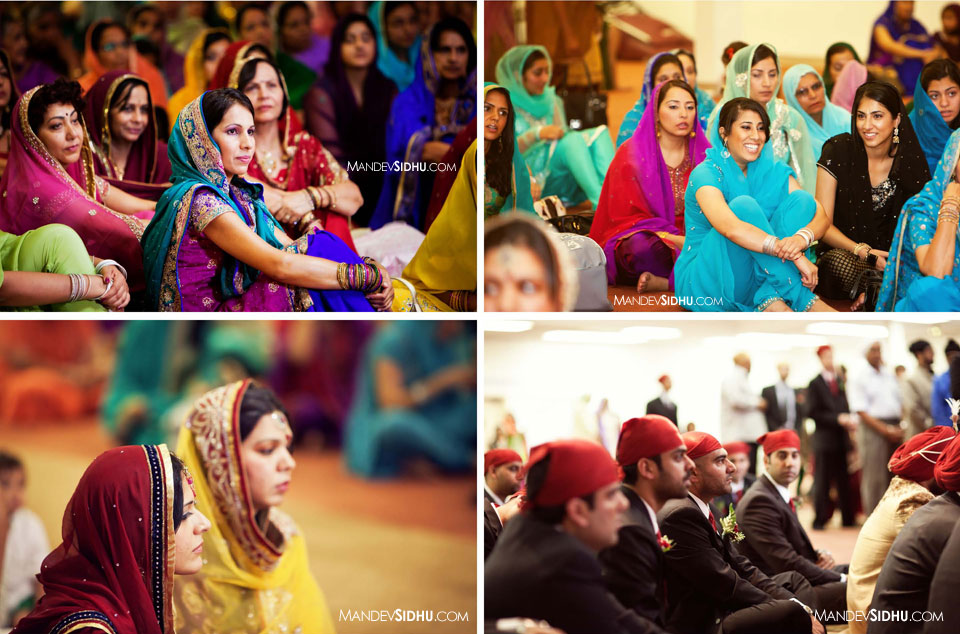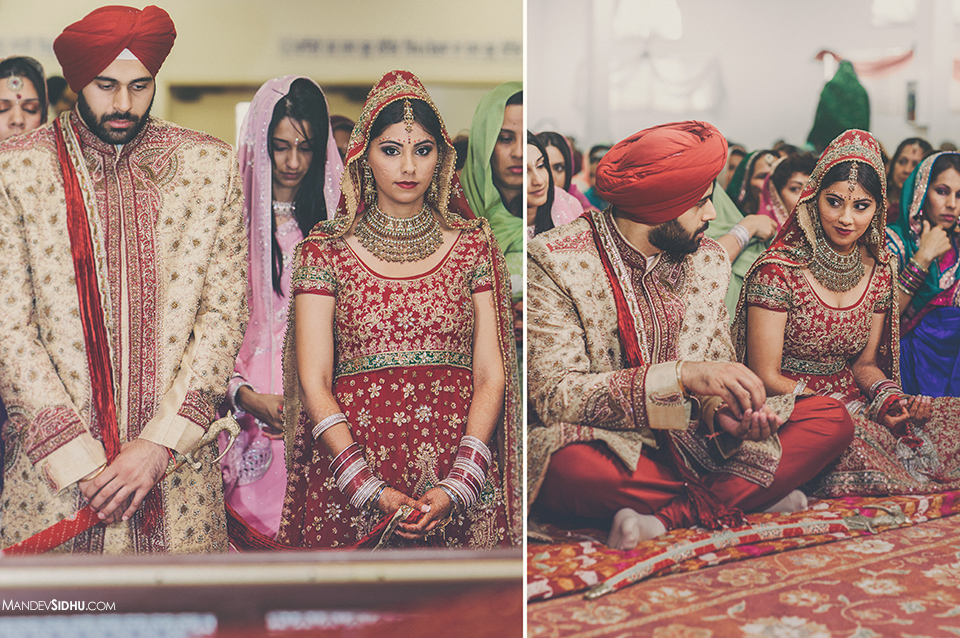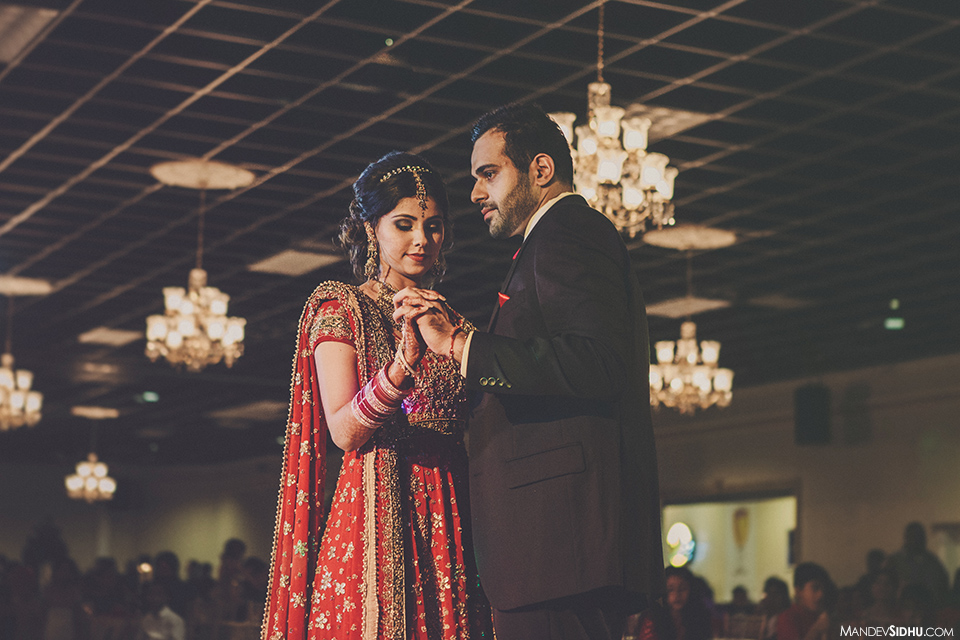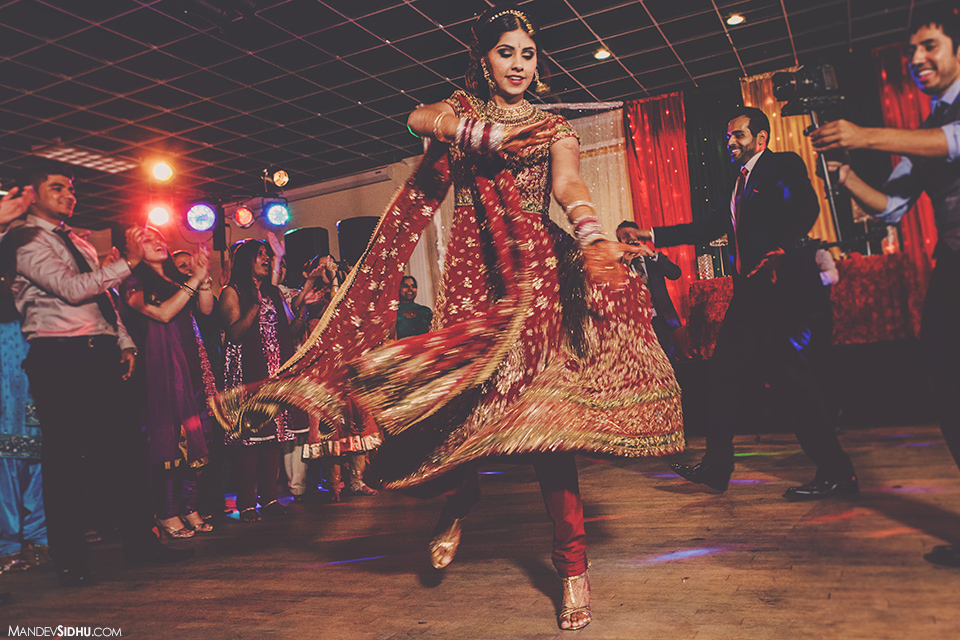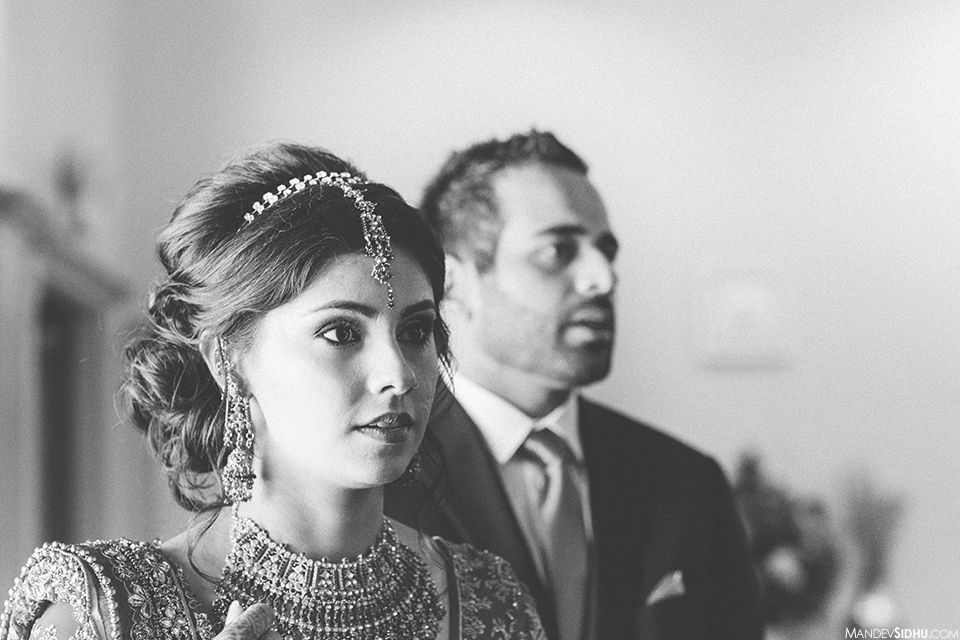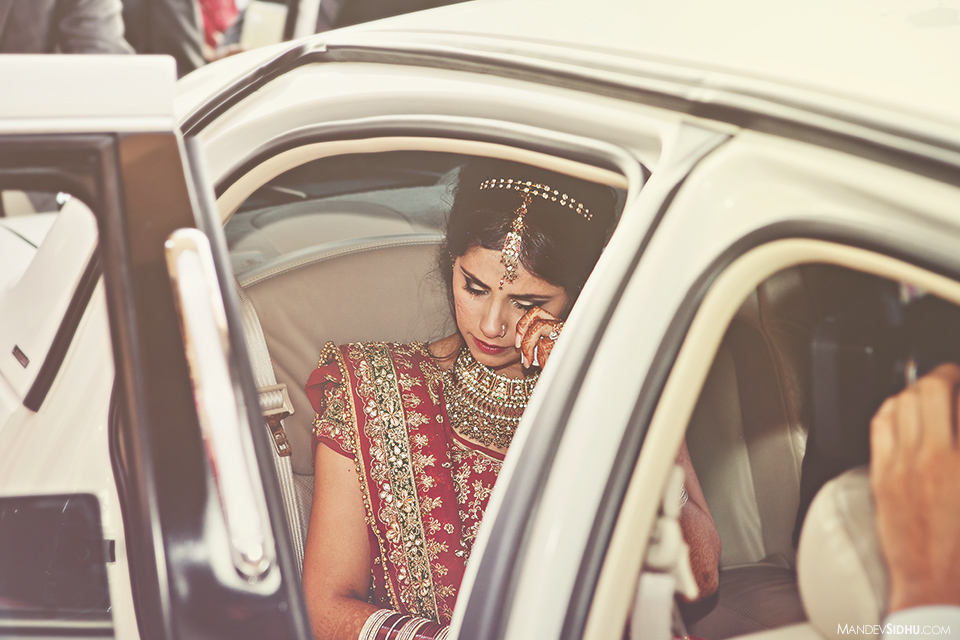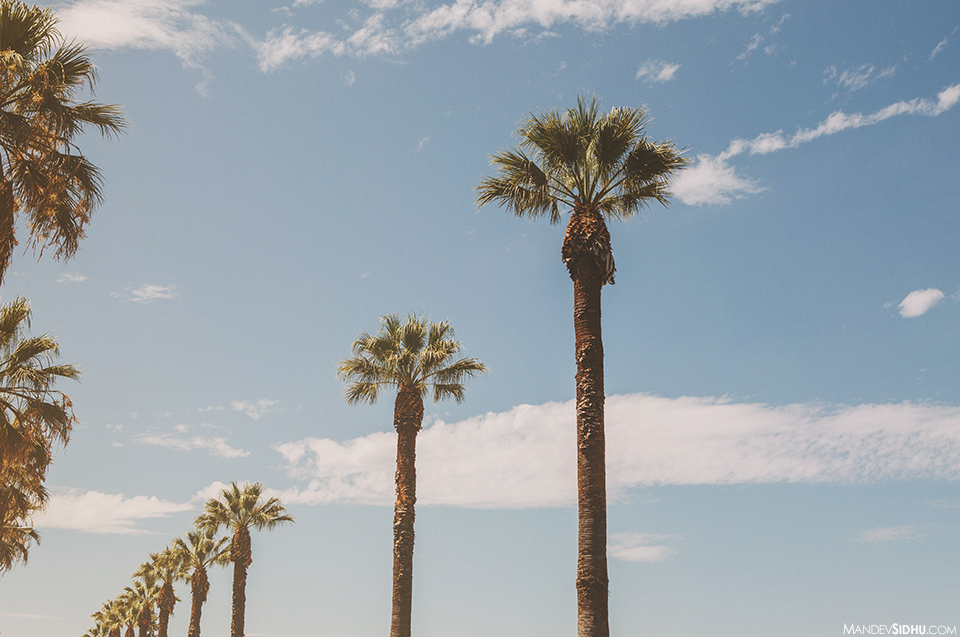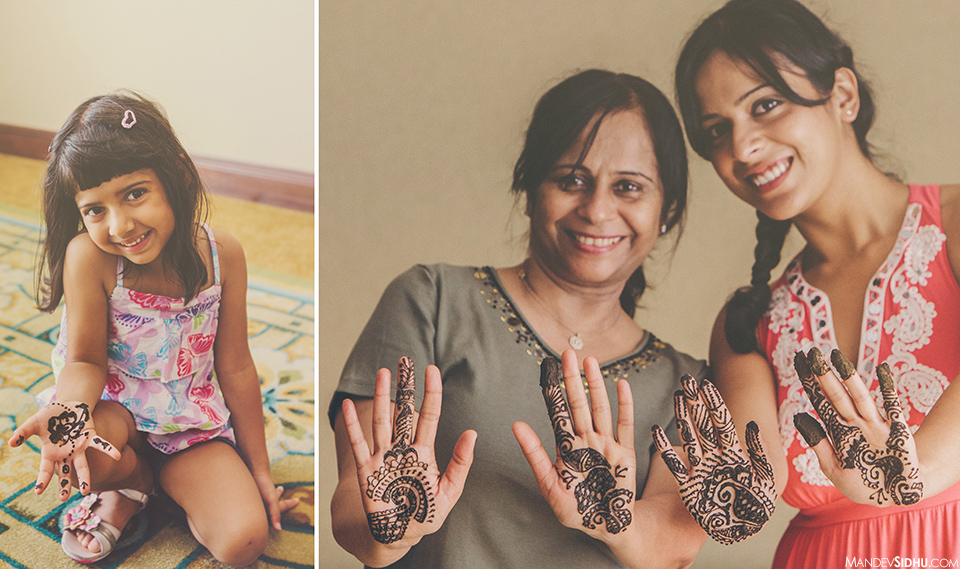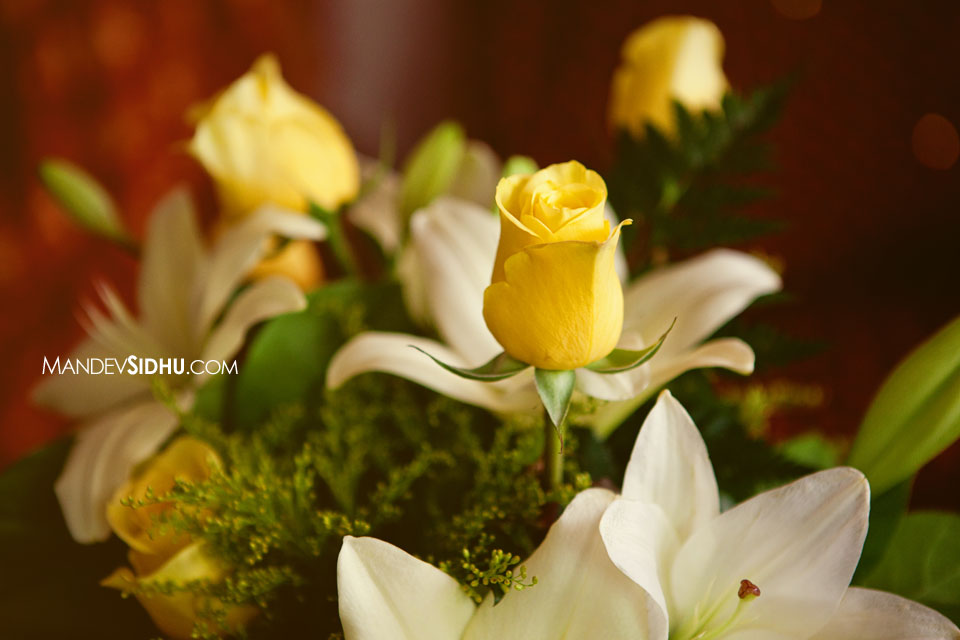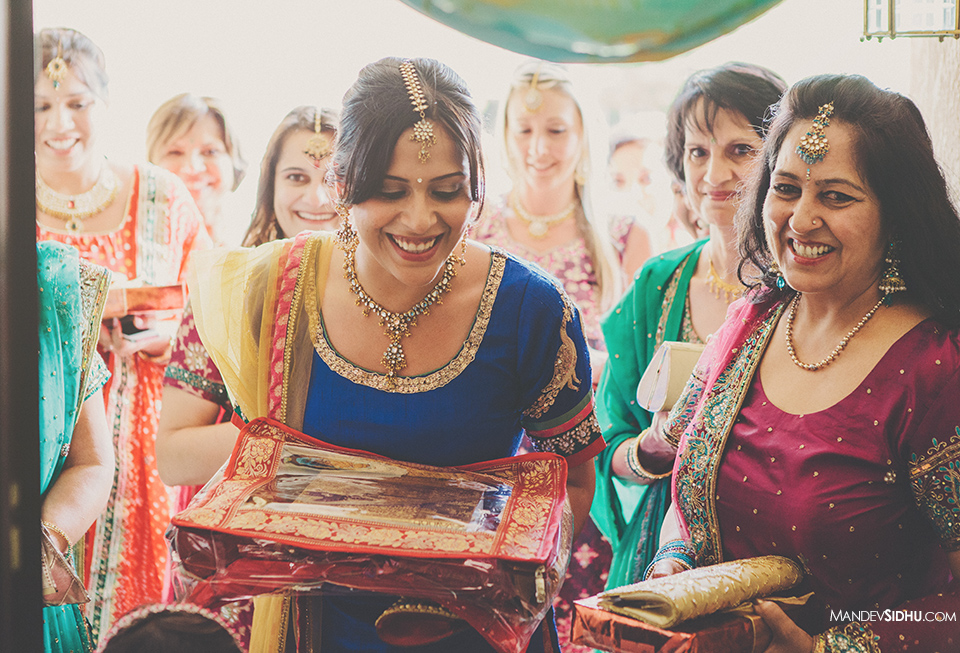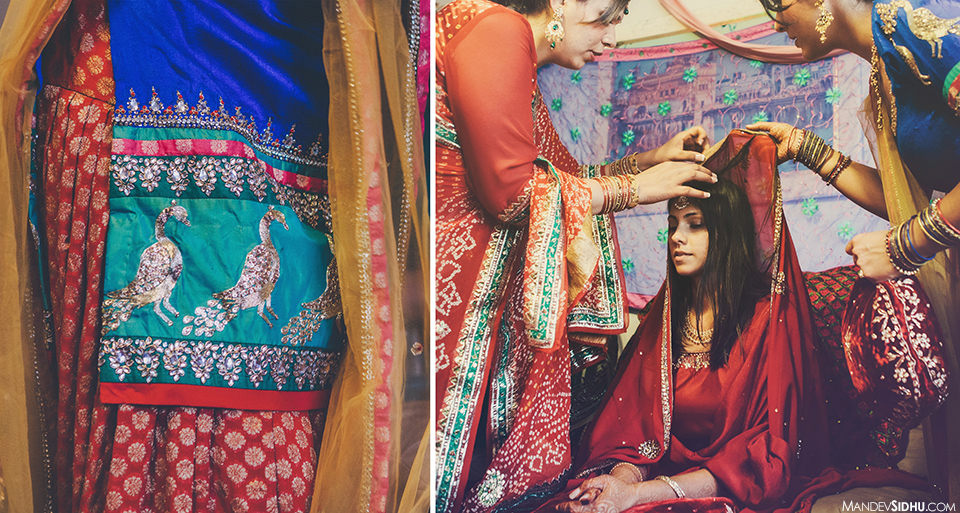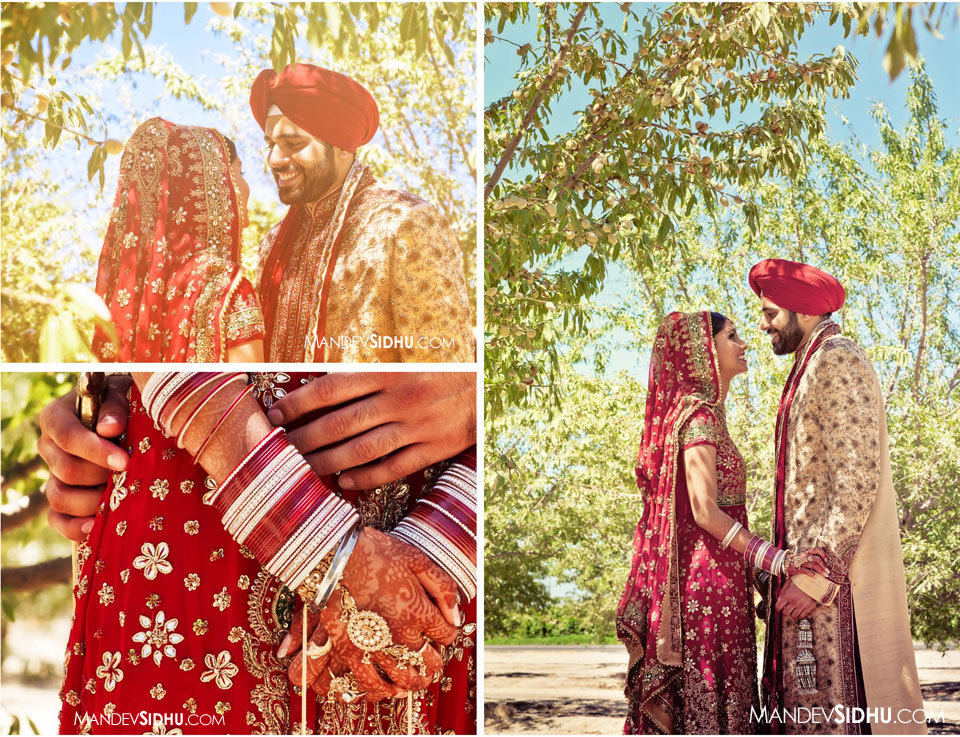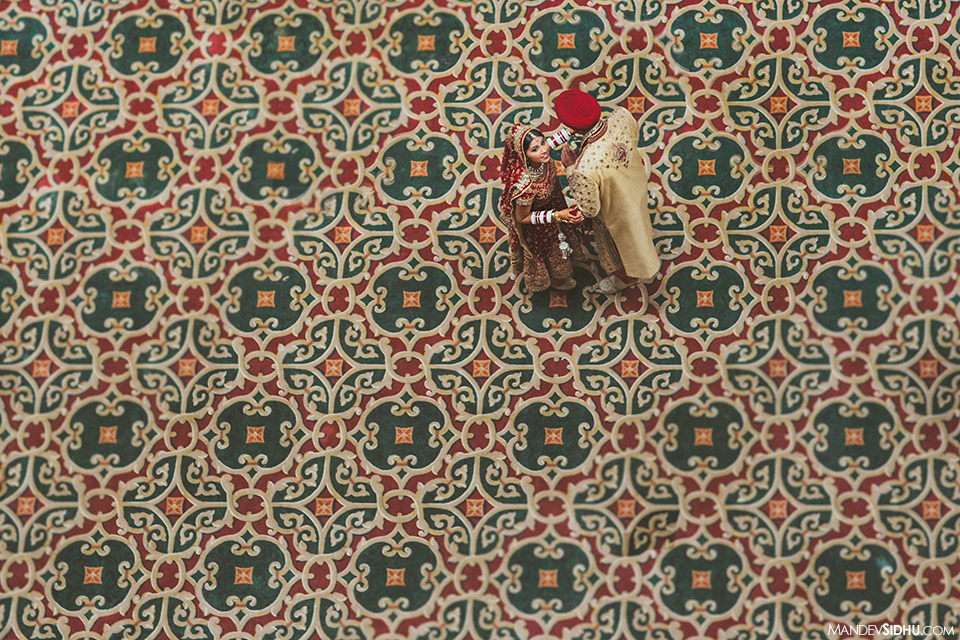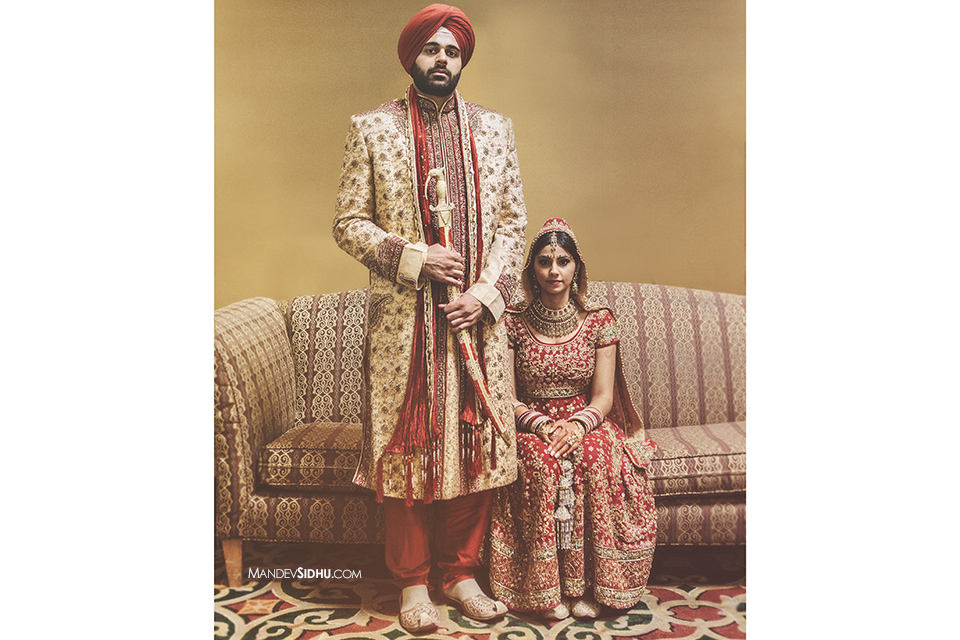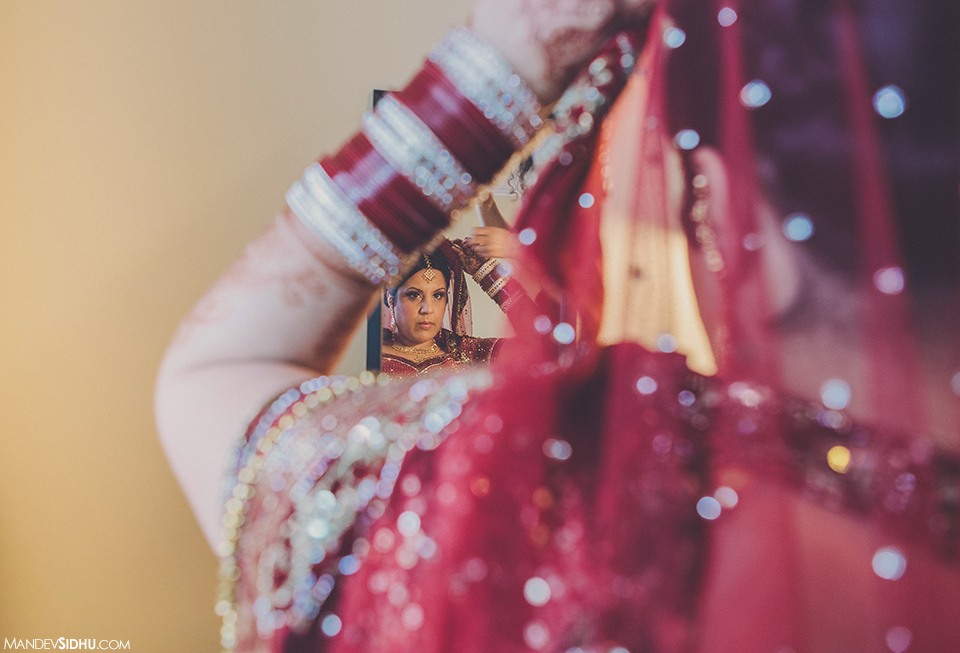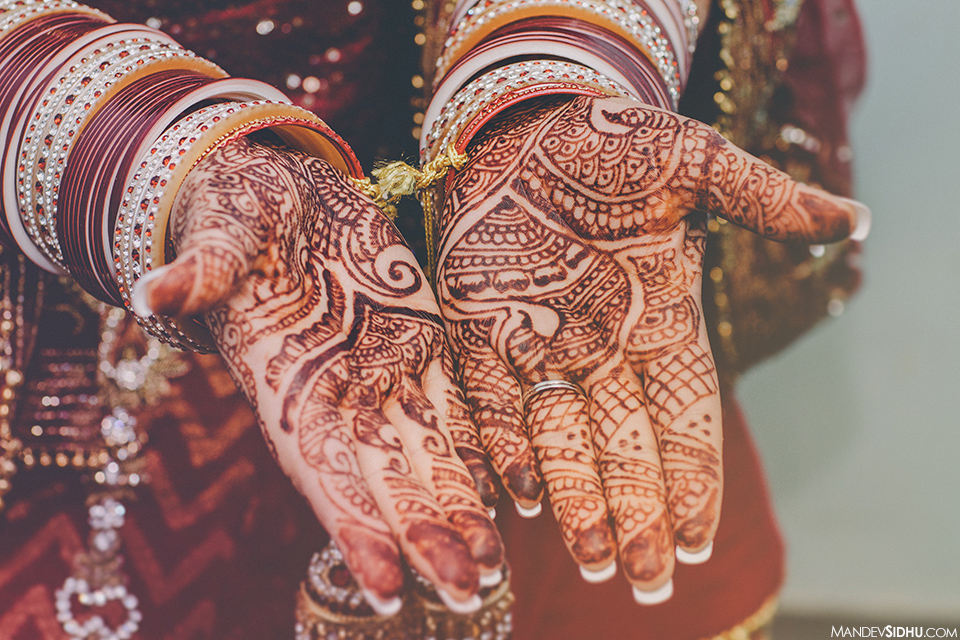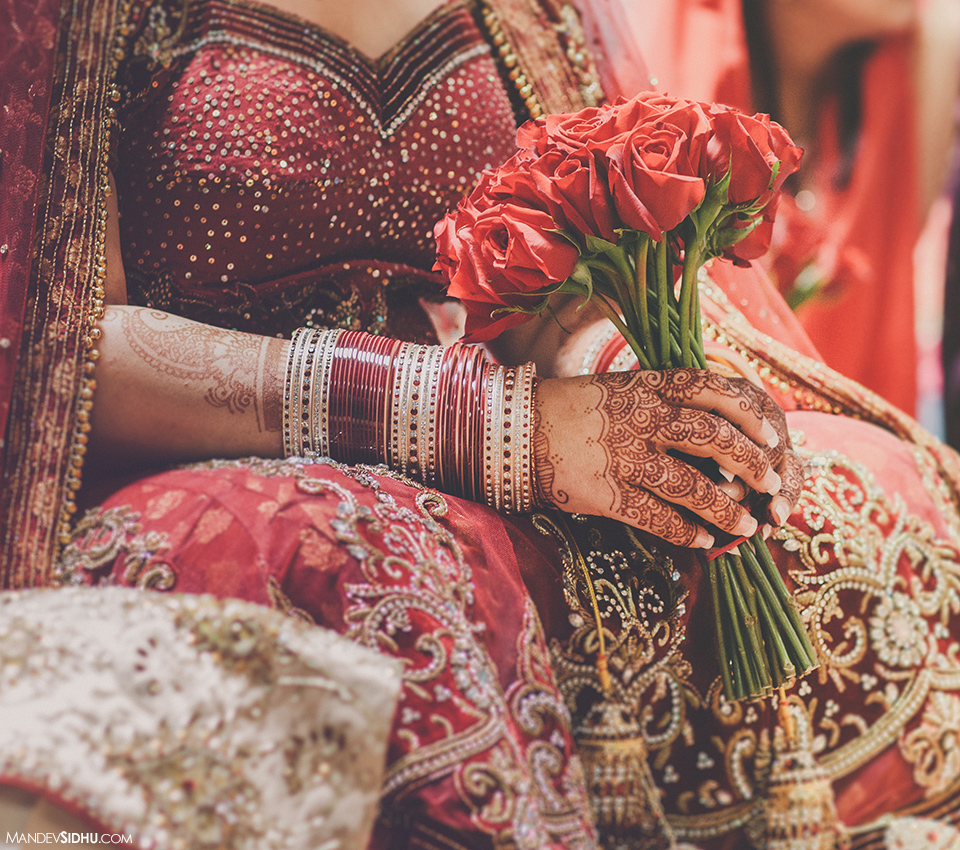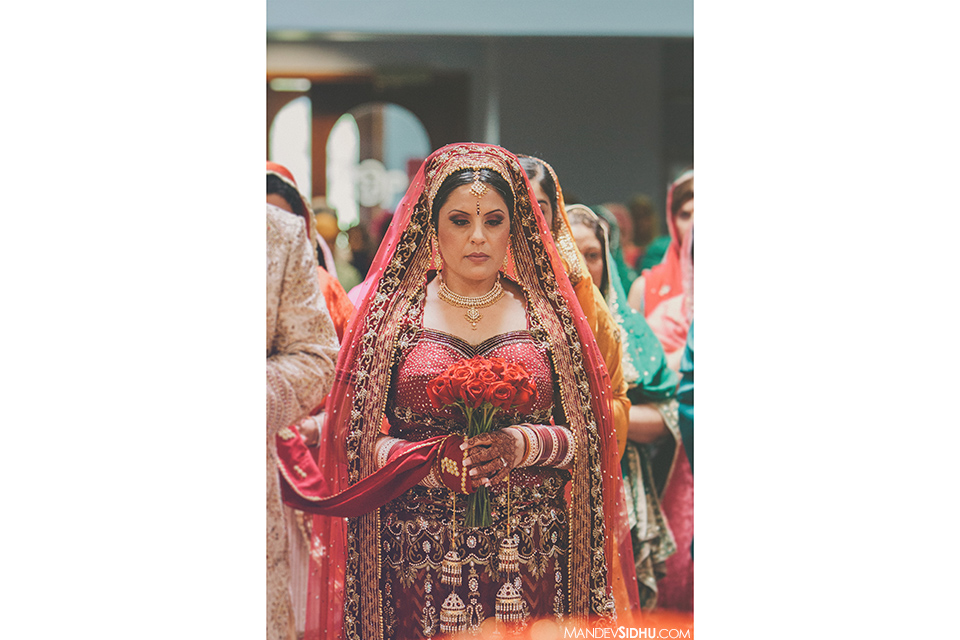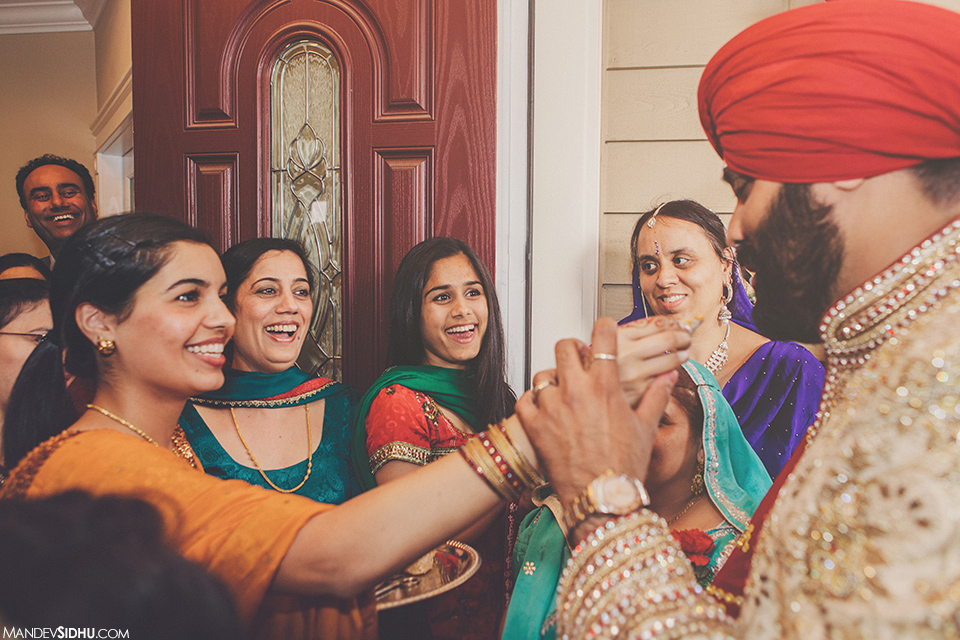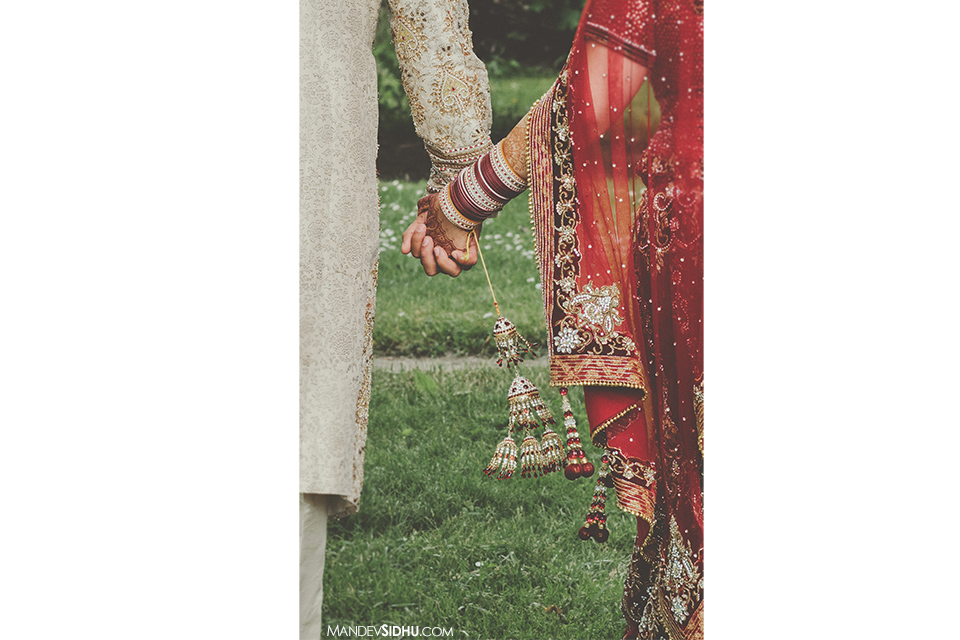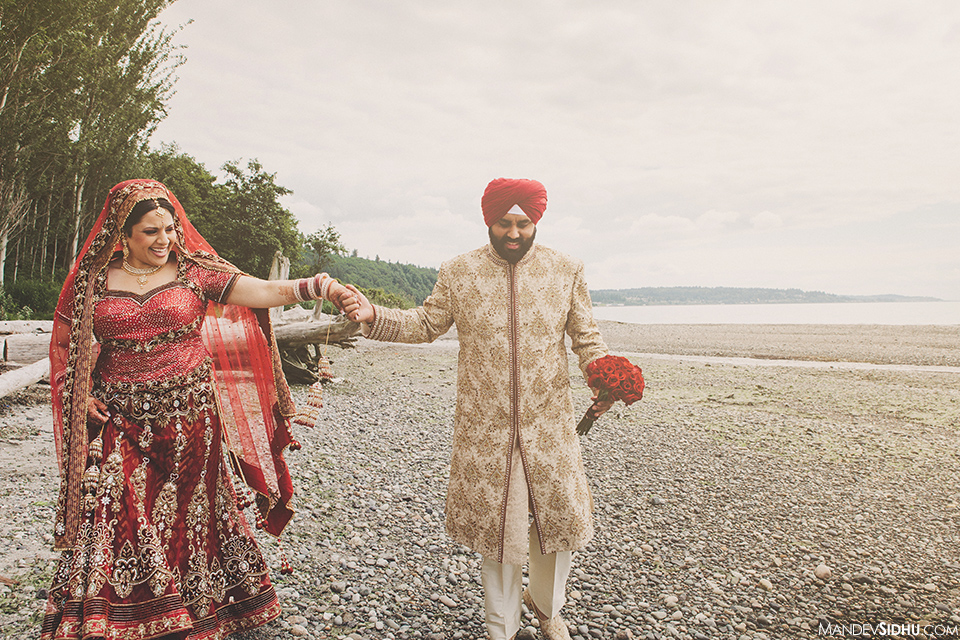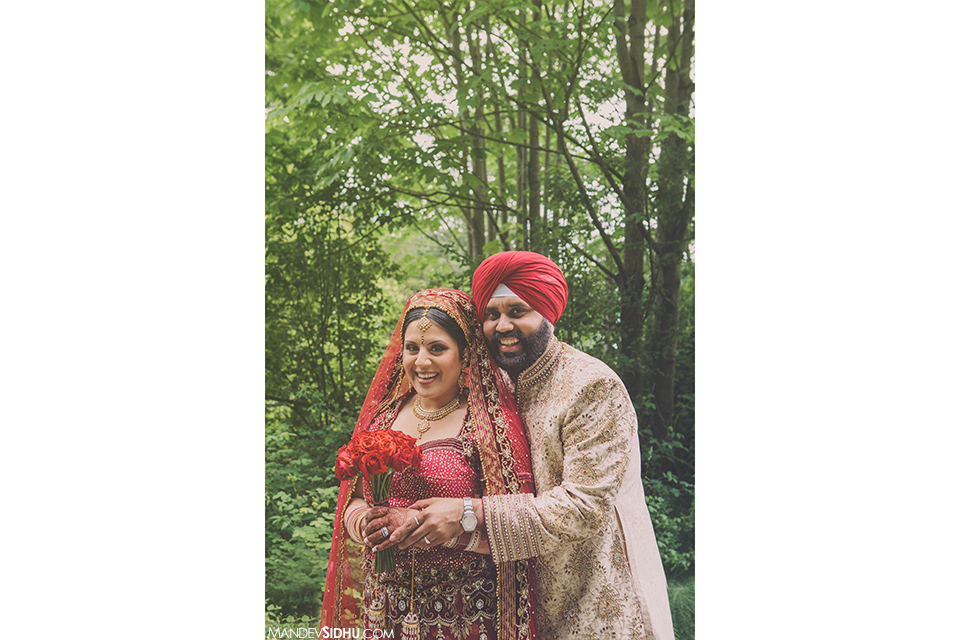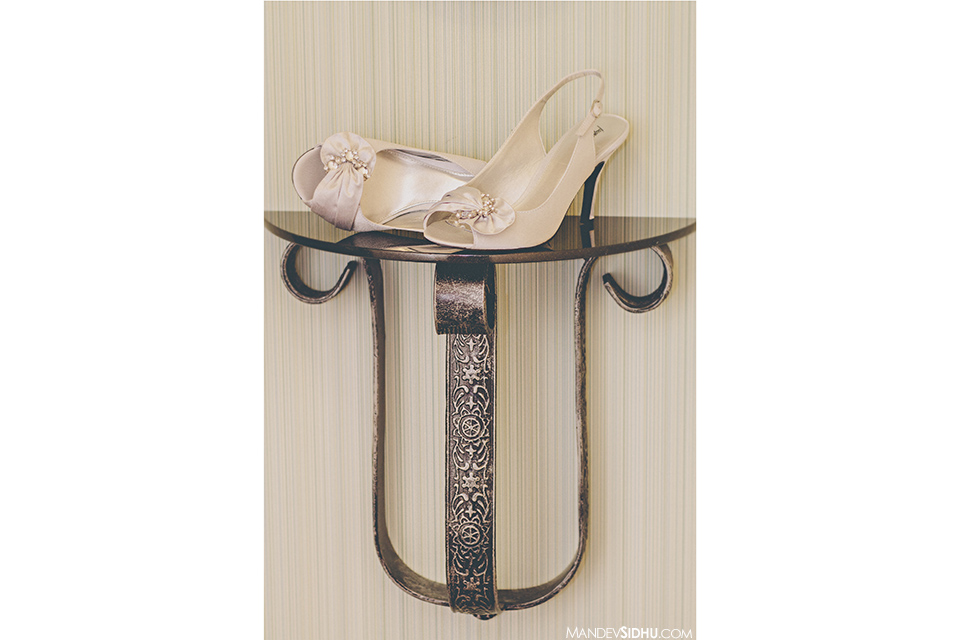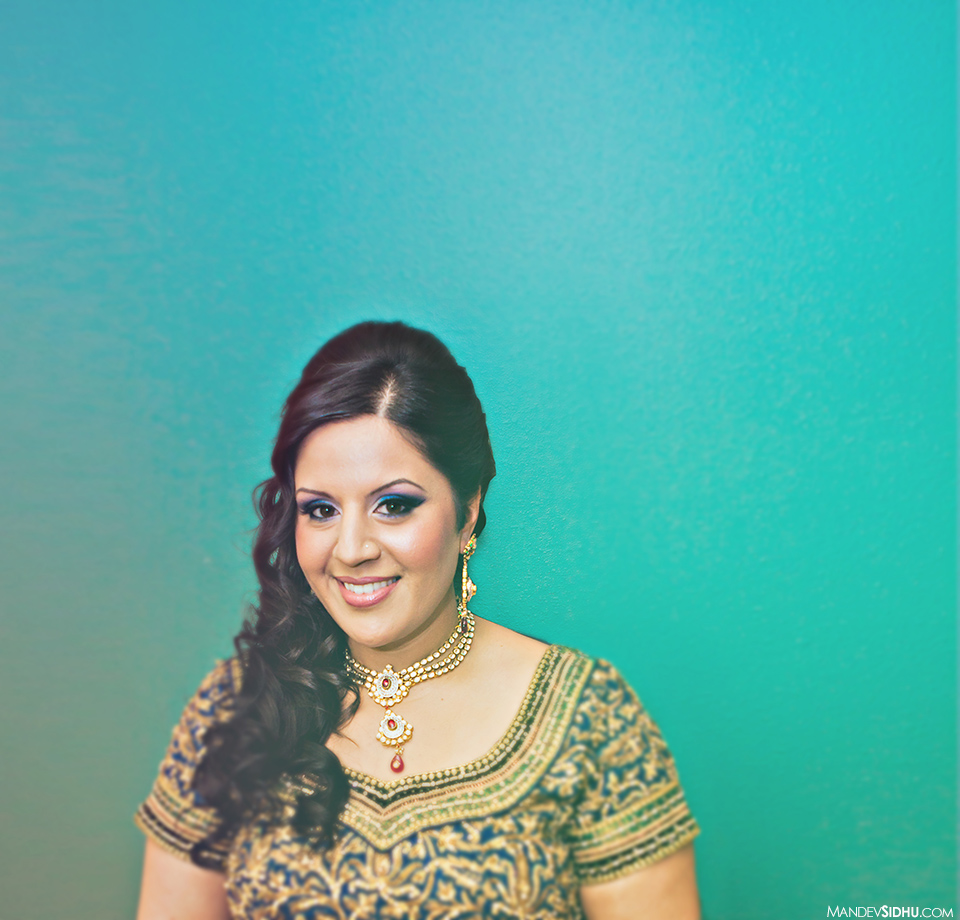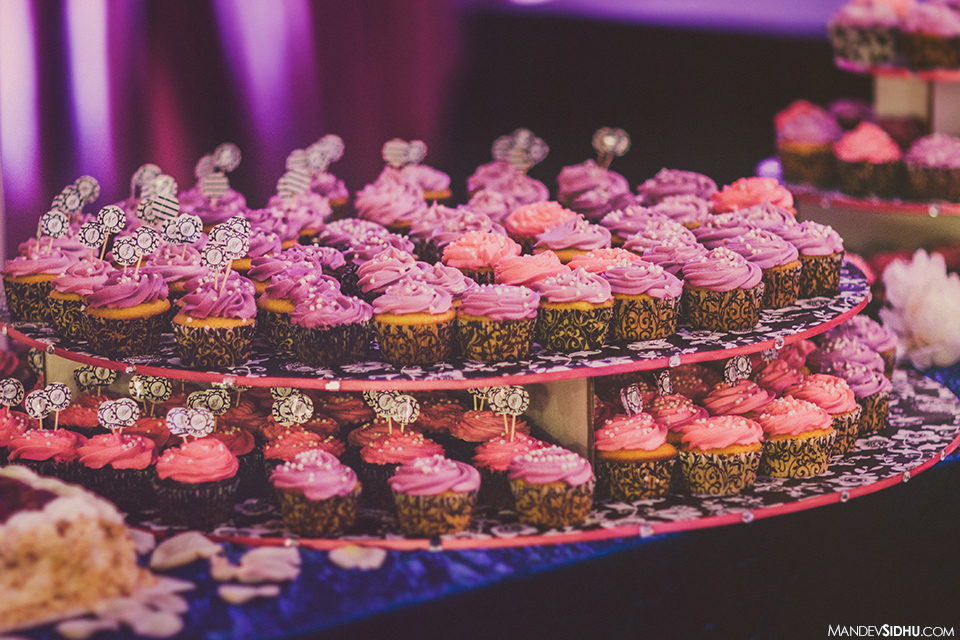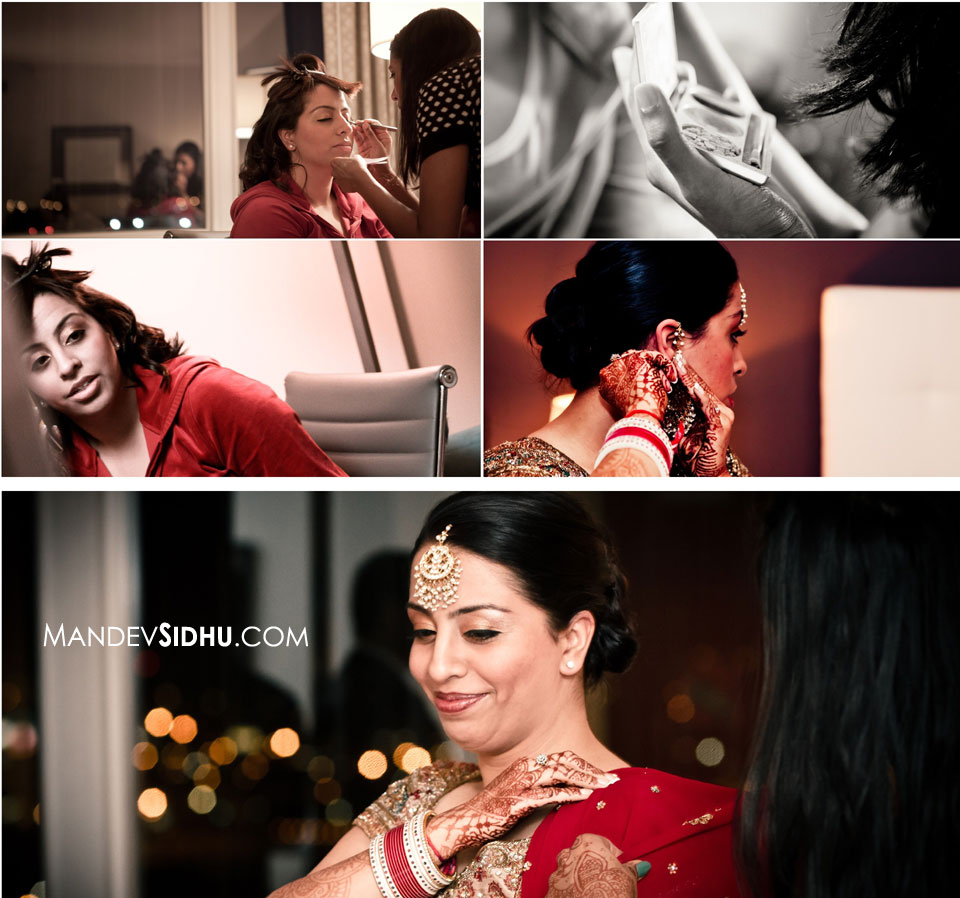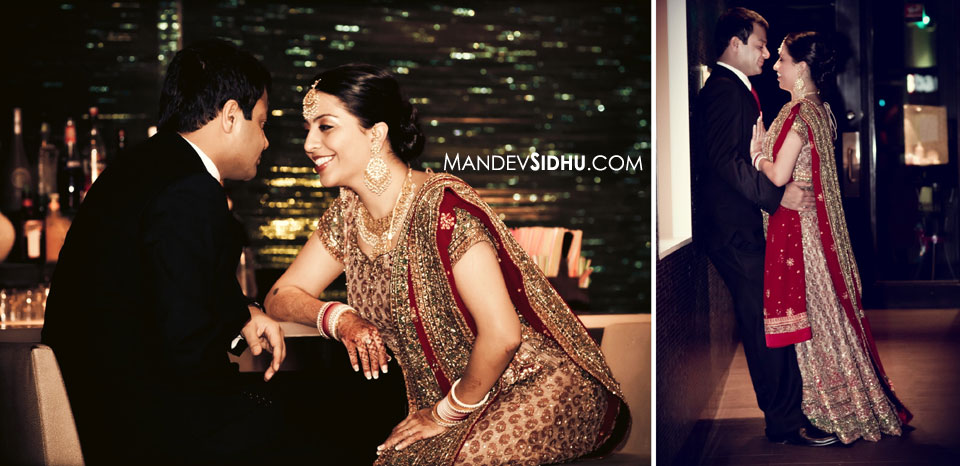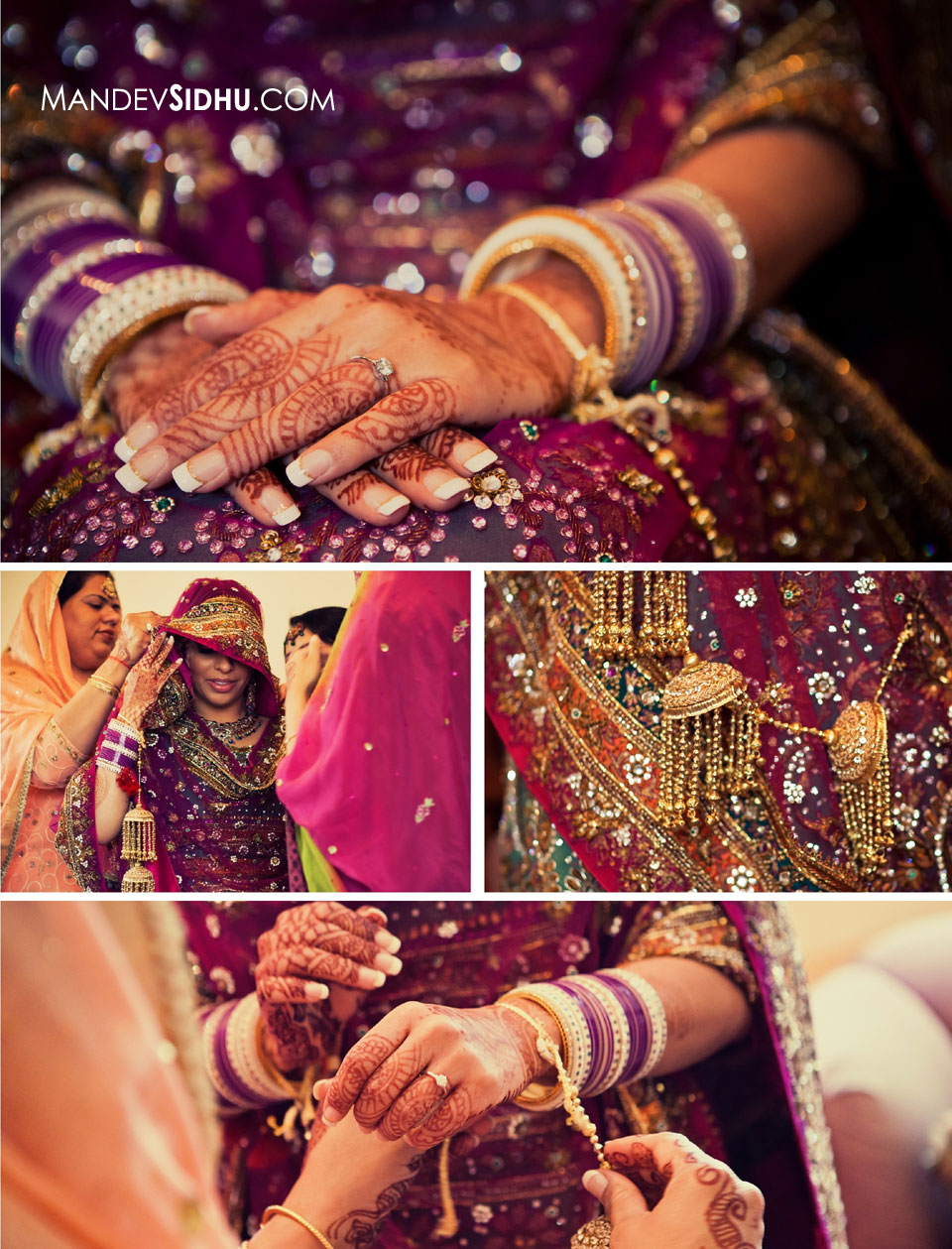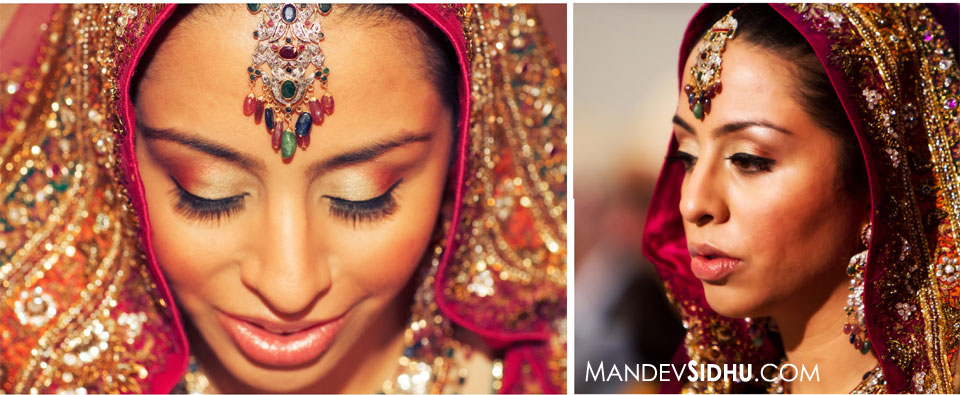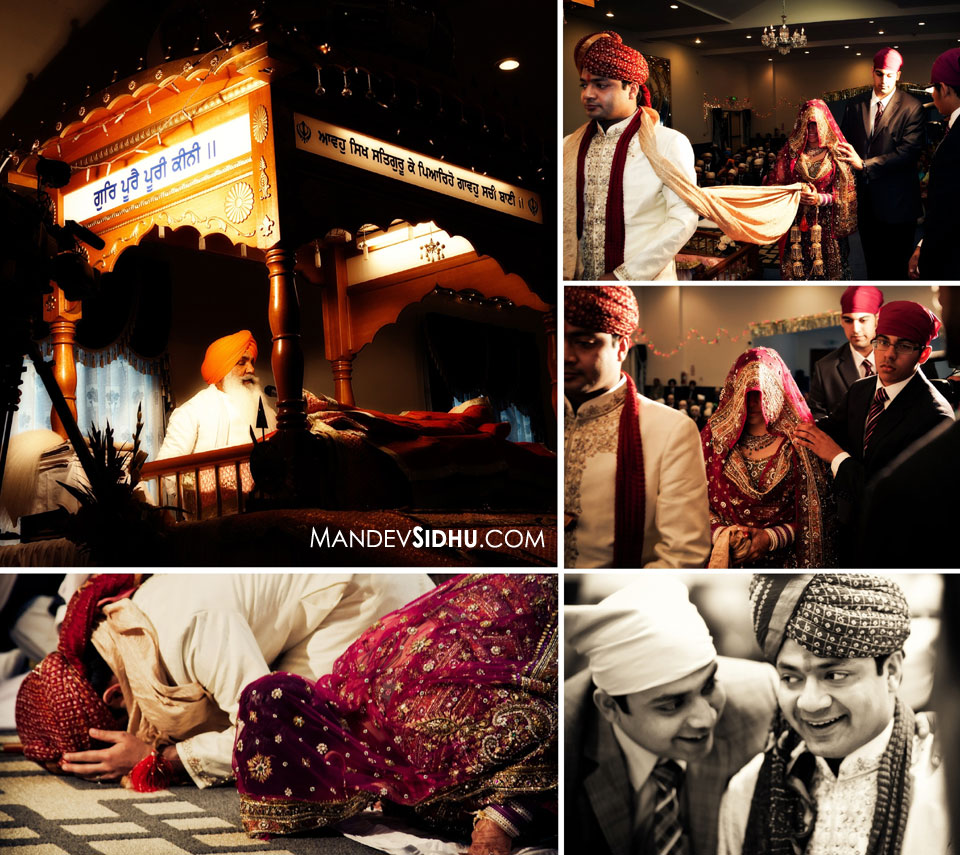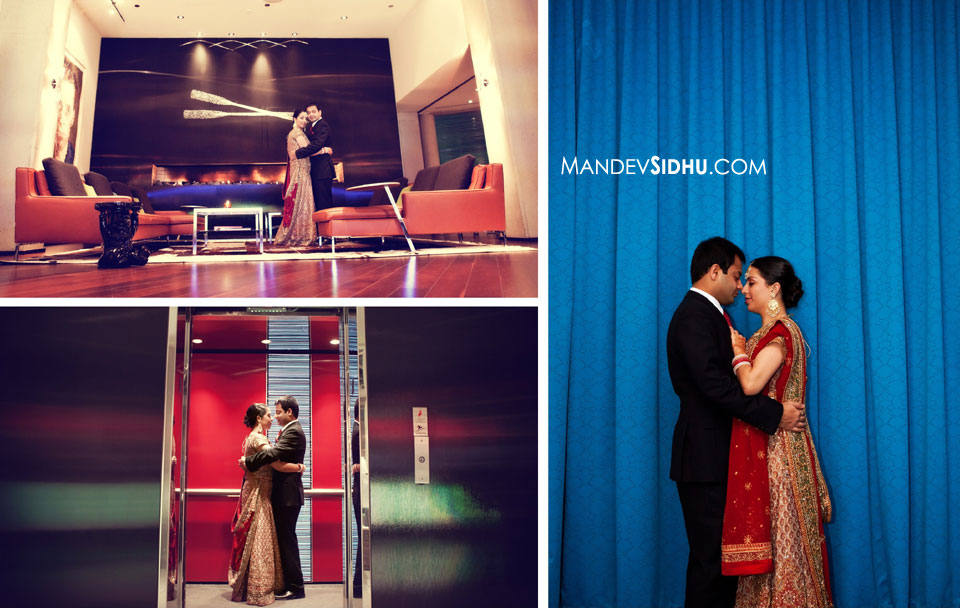Mick and Karen’s Sikh wedding in Fresno, CA, was overflowing with excitement and joyous traditions. The photographs in the previous post show their traditional wedding mehndi (henna). The day after mehndi was applied, each family performed the Vatna, Maiyaan, and Sangeet, followed by the Anand Karaj (Sikh wedding ceremony). Below are photographs from each of these Indian wedding ceremonies
Vatna
The vatna is a traditional ritual where a yellow turmeric paste is rubbed on to the bride and groom’s face, arms, and legs. The turmeric, flour, and mustard oil paste is applied to make the skin look radiant for the wedding. In essence, it can be compared to going to a spa before the wedding. Prior to the vatna, the bride/groom’s aunts, cousins, and sisters created a beautiful design, called a rangoli, using multi-colored sand. The rangoli laid at the feet of the bride and groom as family members applied the vatna (turmeric paste). The pictures below show Mick and Karen’s rangoli as well as family members applying the vatna.

The multi-colored sand drawing is called a Rangoli, and is common for Sikh weddings. It’s created at the feet of the bride, where it will remain until the Vatna ceremony is completed. Afterwards, it will be swept by the bride’s mother.
Sangeet | Maiyaan
The sangeet/maiyaan was a ceremony of dancing, singing, celebration, and delicious food. Karen’s sangeet and maiyaan were held at her home, whereas Mick’s family held theirs in a banquet hall. (Traditionally, the groom’s family would do this at their own house, but considering Mick’s house is in Seattle and the wedding was in Fresno, it would have been a long commute 🙂 )
To begin the evening of dancing and celebration, the maternal side of each family brought out the jaggo. The jaggo is a lit lantern held on top of the ladies’ heads. In India, the ladies will dance through the village with this jaggo (lit lantern) to let everyone know about the wedding. Karen’s family actually walked through the neighborhood, singing, dancing, and carrying the jaggo! How awesome is that?!!!! So much fun!
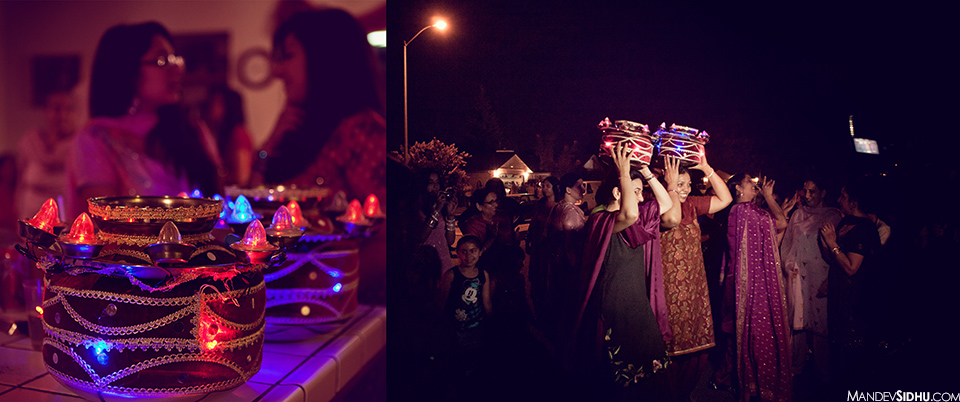
The jaggo (lit-lantern) can be seen above. Some people choose to use candles, others use lights. I love that Karen’s family followed the tradition of having the ladies walk through the neighborhood while singing songs. It was awesome to see them walking through the streets, dancing, and passing the jaggo from one lady to the next.
The Wedding Day
On the wedding day, Karen wore a beautiful red Anarkali lehenga along with a beautiful gold necklace and gold earrings. Her outfit perfectly complimented Mick, who wore a traditional Sherwani and red turban. You’ll notice a plume of white feathers on his turban. This is called a kalgi, which was put onto his turban by his sister, Kim. Mick wore it until he entered the Gurdwara, at which time Kim removed it from the turban.
Bharaat | Milni
After Karen finished getting ready, her family took her to the Gurdwara (temple) where they waited for Mick’s family to arrive. The groom is accompanied by his family and friends as they travel to the temple. This is called the baraat. Mick carried a ceremonial sword and arrived on a white horse. It was an amazing sight- full of smiles, laughing, and positive energy as Mick’s wedding party danced to the sounds of a beating and rhythmic dhol. Traditionally, the groom is accompanied by a young nephew or cousin, who also wears similar clothing as the groom. He is called the “shabbala” or caretaker of the groom. You can see him in the pictures of Mick’s baraat.
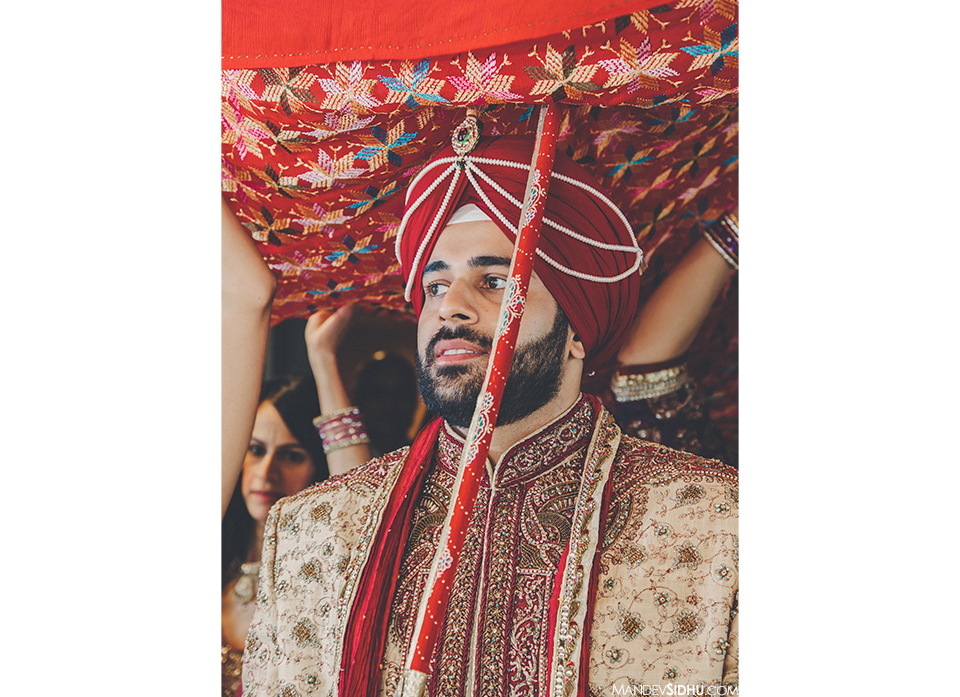
The Baraat began at the hotel. Here, Mick’s family led him to the car, where he and his mom drove to a location near the temple. Once they reached the Gurdwara, Mick got onto a white horse, and his entire wedding party, consisting of family and friends, followed him to the Temple. Meanwhile, Karen’s family was waiting at the Gurdwara to receive and welcome Mick’s family.

Mick and his Shabbala rode the white horse to the Gurdwara. They were surrounded by their family, who danced in the streets. In this picture, you can see Mick’s sister, Kim.
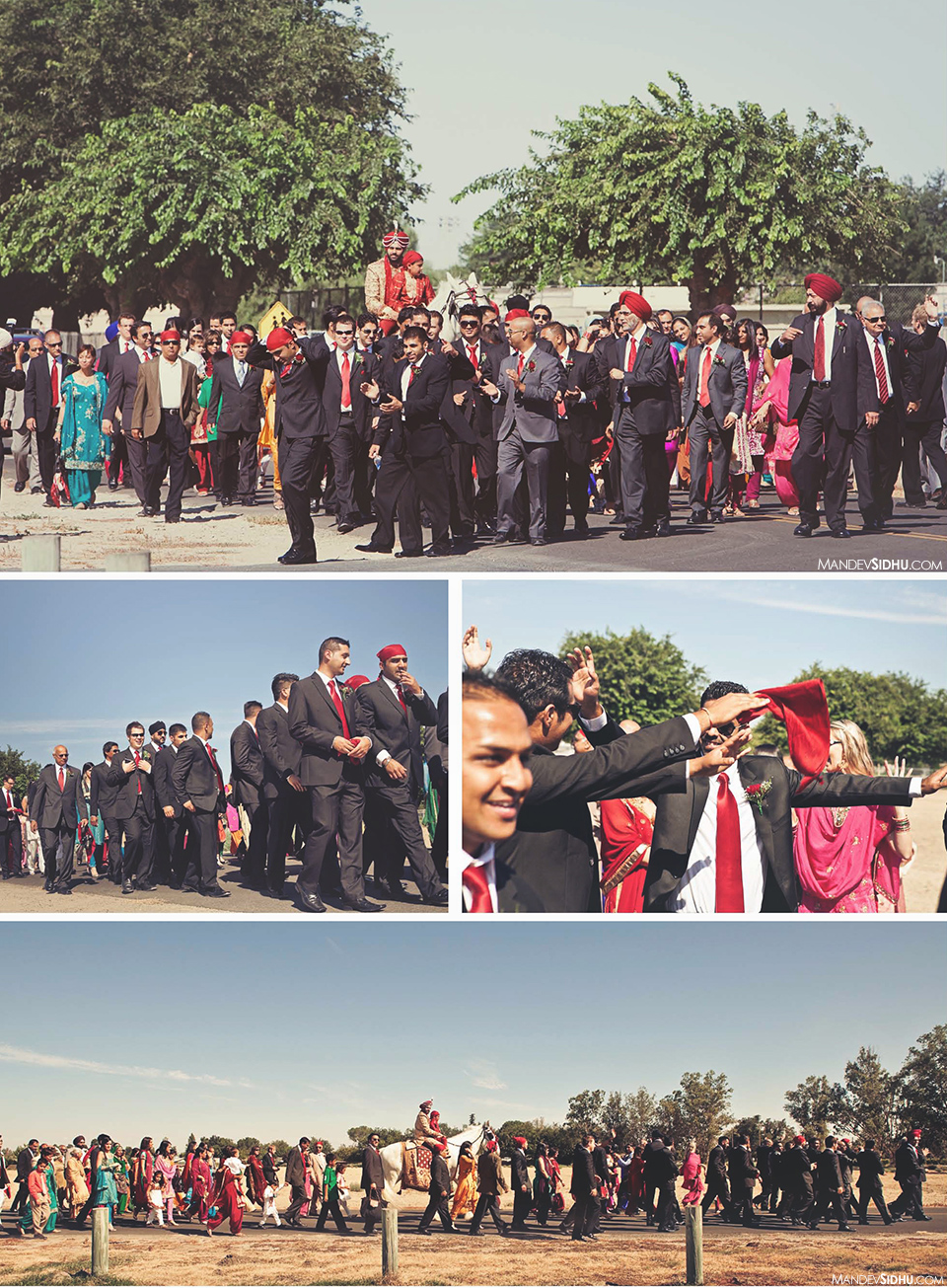
The baraat walked down the street, laughing, dancing, and singing as they made their way to the temple.

The baraat danced to the sound of the Dhol. The Dhol is a tradition Indian (Punjabi) drum used for dancing and celebrations. The sound is very loud and carries a strong upbeat, fast tempo. It’s impossible not to dance when you hear the dhol. The gentleman playing this dhol is one of the best I’ve ever heard. He was very, VERY good.
Upon reaching the temple, Mick’s family was greeted by Karen’s family and the priest, who said a prayer of blessing (Ardaas). The milni is a formal meeting of both families. The fathers, grandfathers, uncles, and cousins exchanged fresh flower garlands. This is a happy occasion where the families are excited to meet each other. Sometimes, in India, it was here that some family members met for the first time. Once the garlands have been exchanged, the brides family offers sweets to the groom’s family as a welcoming and blessing.
Anand Karaj | Blissful Union (Sikh Wedding ceremony)
The Sikh wedding ceremony is called the Anand Karaj which is directly translated as “blissful union.” The ceremony began with the singing of hymns. Mick entered the prayer hall with his family and sat with the congregation. Before Karen’s arrival, Mick moved to sit in front of the Granth Sahib (Sikh holy book), and at that time his sister, Kim, removed the kalgi from his turban. Karen entered the prayer hall with her father, brother, mother, and cousins. After she took a seat next to Mick, the formal wedding ceremony began. The priest said a prayer, followed by a hymn, and then the lavaan. During the lavaan, the bride and groom walk around the Granth Sahib four times. Each round has a special meaning of commitment and spiritual awareness. After this, to conclude the ceremony, the entire congregation stoodd for a special prayer of blessing.
I hope you enjoy these photographs of Mick and Karen’s Anand Karaj. I had so much fun during their wedding and wish them both a blessed life of happiness.

The groom’s sister is removing the white Kalgi from the groom’s red turban before the Anand Sahib (wedding) ceremony begins.
Mick and Karen’s Indian Wedding Reception
This is one of my longer blog posts and although it contains a ton of photos, my intention is to convey the feelings, customs, colors, and traditions of an Indian Sikh wedding. I plan to elaborate on these descriptions, so when guests attend a Sikh wedding, they can appreciate and understand the culture behind the ceremonies. Because Mick and Karen did such a wonderful job of incorporating these traditions into their wedding, I’m so happy to use these photos as a visual guide to Sikh Wedding festivities. If you have any questions about a Sikh wedding, please leave a comment below, or send me an email!
Thanks Mick and Karen, and a huge thanks to my brother, Tanvir, for helping me photograph this awesome Indian Sikh wedding! I love having him on the team!
I’d love to connect with you on Google+ and Instagram (@MandevSidhu)
You can also find me on Facebook here. <– ‘like’ my page to follow more photos
Mick and Karen’s traditional Sikh wedding in Fresno, CA, was absolutely beautiful! Surrounded by acres of almond fields, fruit trees, and rolling hills, the area provided the perfect backdrop for a wedding. Palm trees lined the road as we drove through fields and fields of fruits and vegetables. I love photographing Indian weddings because of all the celebrations, traditions, and the excitement from both families.
We spent 3 days in Fresno, capturing the memories and traditional festivities of the Sikh wedding. As we photographed the many cultural traditions and events, it felt as though we were part of the family. Everybody opened themselves up to us, showing love, and that truly made our job memorable.
Over the past 8 months, I’ve witnessed the kindness and friendliness of Mick and Karen. Throughout the entire wedding, they placed a lot of trust in us, opened themselves up to creativity, and were just so cooperative. From the day we took engagement photos in downtown Seattle, I knew Mick and Karen were going to be awesome! They make such a perfect couple – Karen has a funny personality and a warm heart, and Mick is hilarious and always so understanding. There’s a sense of calm and peace in their relationship that I can only imagine developed through their years of long-distance. They’ve really established a deep level of trust and understanding with each other, and it stems from their communication and openness. After spending time with their families, I can see where they got these wonderful qualities!
Mehndi (Henna)
Mick and Karen’s Indian wedding was comprised of several Sikh traditions, each of which were performed with happiness, huge smiles, and love. Sikh weddings often occur over the span of several days, traditionally beginning with the application of Mehndi (henna). The photos below show the mehndi being applied to the hands. Usually, only women will have mehndi applied.
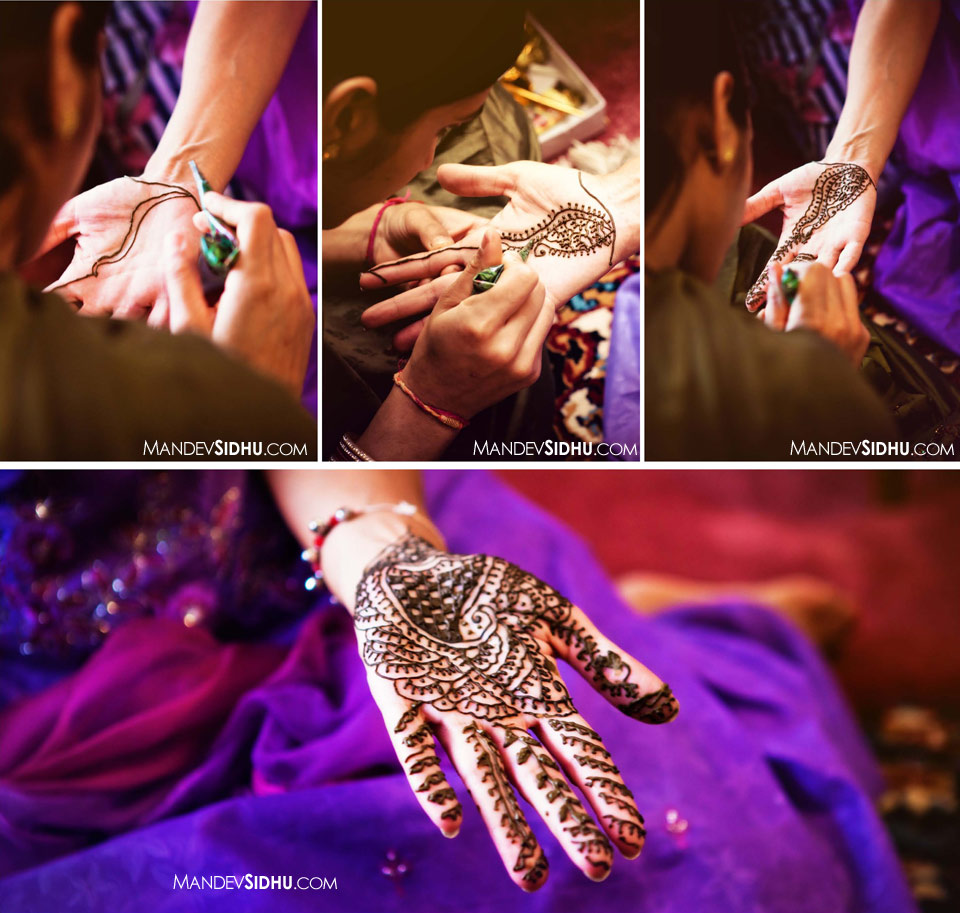
For both sides of the family, the mehndi is carefully and artistically applied onto the women’s hands. The bride’s mehndi is applied delicately and intricately to both hands and feet. Mehndi serves a decorative purpose, as well as the traditional signification of an upcoming wedding. In India, the mehndi was prepared by the groom’s mother, and sent to the bride a month before the wedding. The preparation is a long and tedious process where leaves of the Mehndi tree are hand-ground into a paste. The more thoroughly the leaves are ground, the darker the resulting henna will appear. The resulting paste is then left to sit allowing it to become usable.
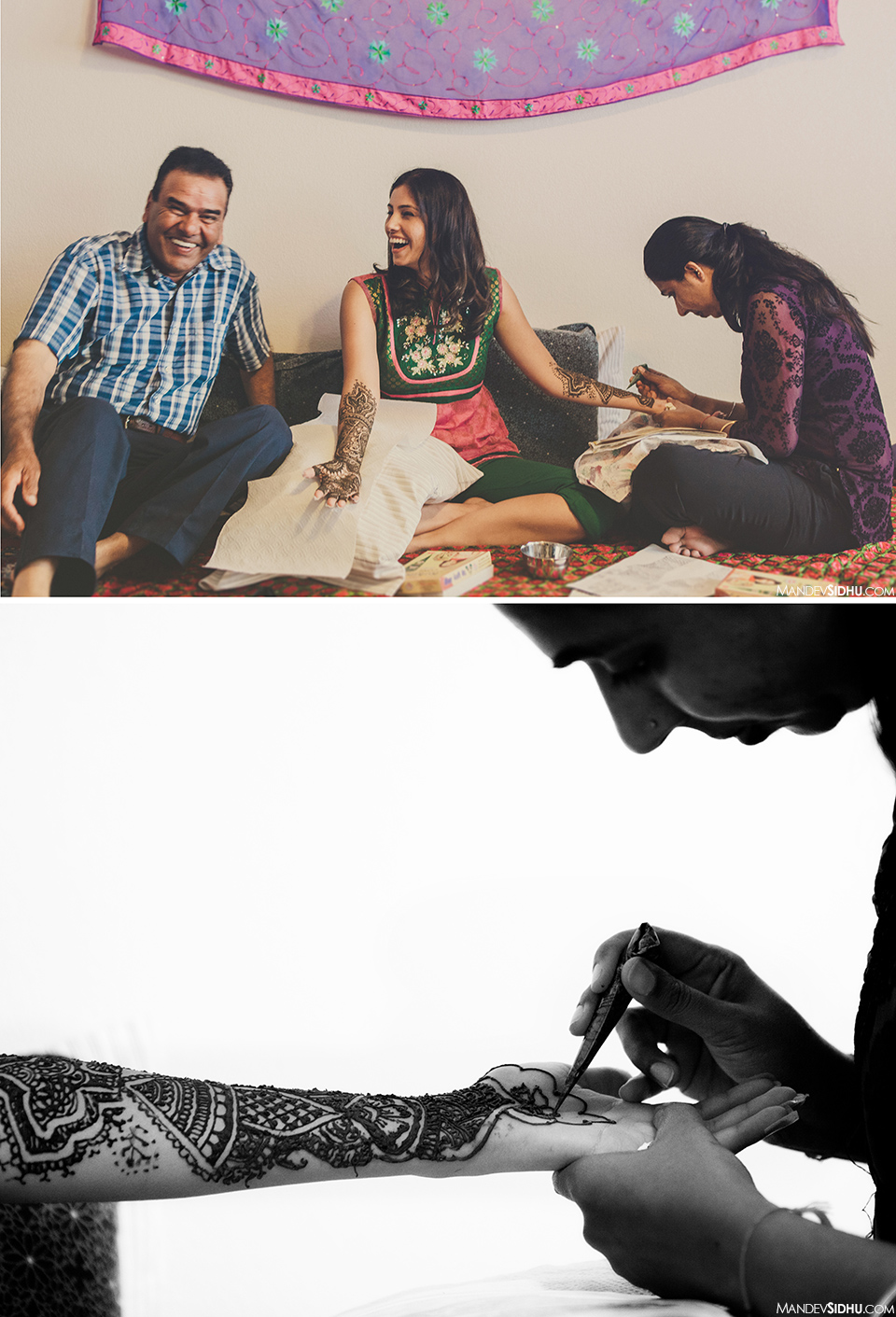
Sikh bride having her henna applied before the wedding ceremony. Mehndi is applied to the hand very carefully and can take many hours. Once done, the bride is left with a beautiful, artistic, design on her hands, arms, legs, and feet. This is an Indian tradition that is still practiced today, all over the world.
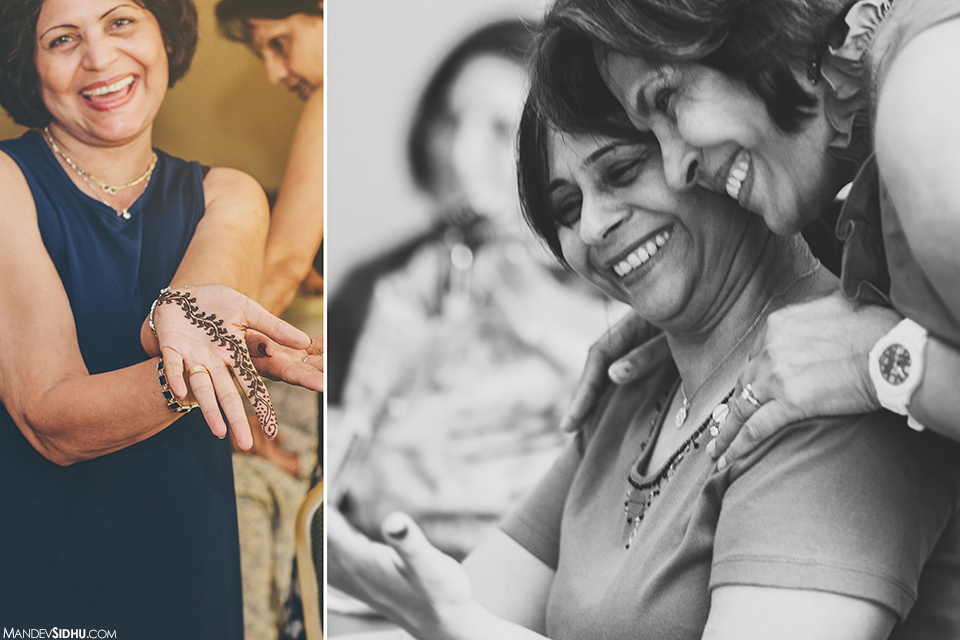
For Sikh weddings, women on the groom’s side also apply mehndi to their hands. I love how happy everyone was at this wedding!
Another tradition is for the grooms family to visit the bride’s family with gifts. During this ceremony, the groom’s mother (bride’s mother-in-law) places a chunni (scarf) over the brides head. This is a sign of respect from the mother-in-law and signifies a lifelong of protection and care from their family. Mick’s family brought gifts and sweets to the Karen’s home. These following are just a couple (of many) pictures we captured for them during this ceremony.
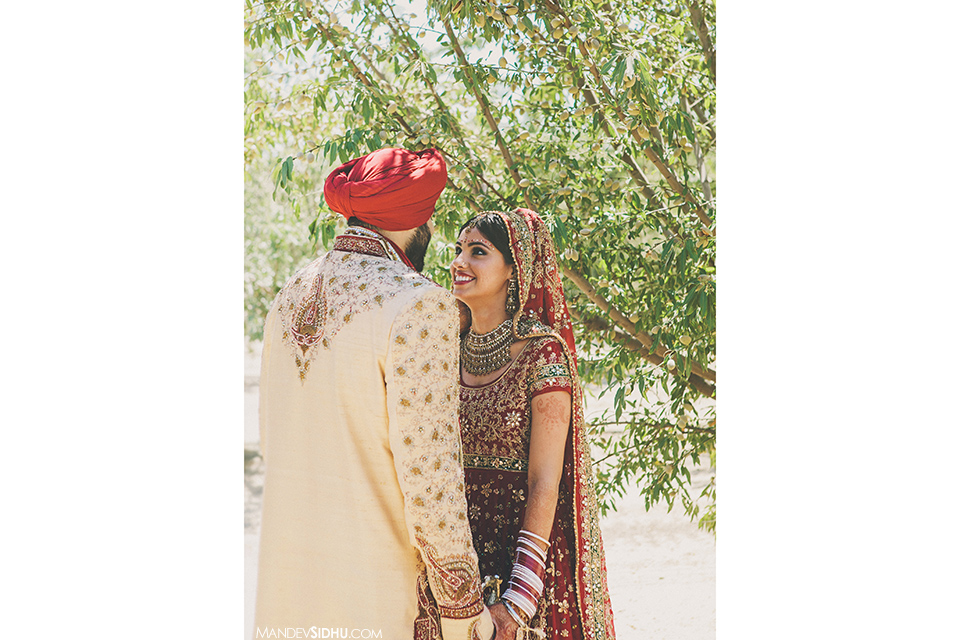
The Gurdwara (temple) where Mick and Karen got married is located among acres of almond orchards. Despite the 100+degree temperature, we took advantage of these beautiful trees. I absolutely love these pictures of Mick and Karen walking through the orchard.
Mick and Karen make such a beautiful couple. These pictures in the orchard are some of my favorite. Even in the 100 degree weather, these two were troopers. Here are a few of the pictures…
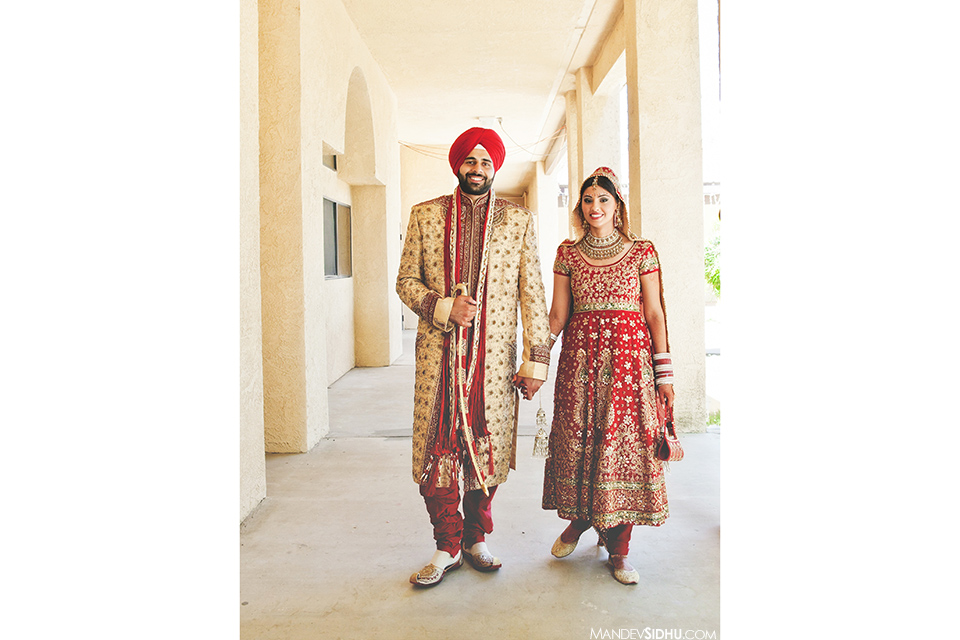
Photo of a traditional Sikh bride and groom, walking through the temple (Gurdwara) after their ceremony.
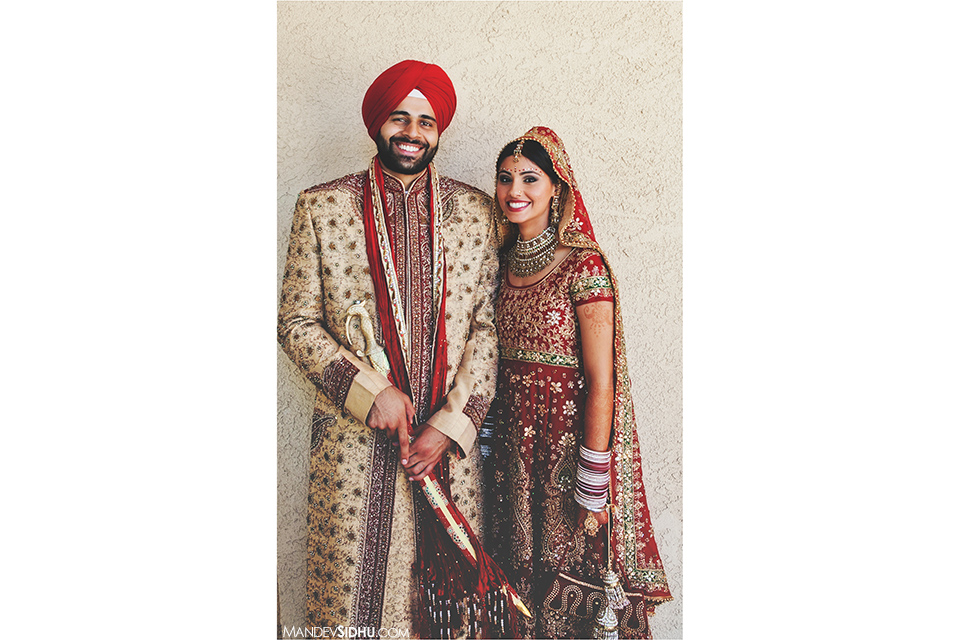
I love this photo of Mick and Karen because it’s a great example of the traditional outfits worn by Sikh bride and grooms.
Thank you, Mick and Karen, for giving me the opportunity to photograph your beautiful, traditional Sikh wedding!
I’d love to connect with you on Google+ and Instagram (@MandevSidhu)
You can also find me on Facebook here. <– ‘like’ my page to follow more photos
Jasmine and Paul’s traditional Sikh Wedding (Anand Karaj) took place at Gurdwara Singh Sabha in Kent, WA. It was a ceremony of Sikh traditions and readings from the Guru Granth Sahib (Sikh Holy Book).
The wedding day began with Jasmine getting her hair styled by the brilliant and talented stylist, Eve Whittington. Eve is based out of NYC and has an amazing portfolio. Make-up artistry was done by the creative Svetlana, based out of WA. They both did an excellent job, and were very fun to work with during the day!
At every Indian wedding, whether Sikh or Hindu, I always look forward to seeing the bride’s Mehndi (Henna). It takes a true artist with a steady hand to apply the paste, which results in a beautiful design. Henna has been used to celebrate auspicious occasions in India and the Middle East for hundreds of years. In fact, there are some accounts of henna being used prior to the 12th century. Traditionally in Sikh and Hindu weddings, the mehndi is applied to the hands and feet of the bride. Not only does it create intricate and beautiful make-up, it also symbolizes the love between bride and groom (husband and wife). **I’m working on an upcoming blog post dedicated to mehndi (henna) – stay tuned.
Jasmine’s mehndi was done by Natasha. I’ve worked with Natasha for a few weddings, and she is an artistic professional with a warm personality. She always does a great job!
The Anand Karaj, or Sikh wedding ceremony, took place at the Gurdwara. The following pictures show the bride and groom sitting in front of the Guru Granth Sahib (Sikh Holy Book) as well as traditional musicians playing classical hymns taken from the Granth Sahib. The Granth Sahib is written entirely in poetic prose, and each section is a unique raag (rhythm).
Some Sikh families follow the tradition of a Dholi, where the bride leaves her parent’s house to go live with the groom’s family. Although nowadays, the bride may not actually live with the groom’s family, the tradition is practiced on the wedding day. The groom arrives at the bride’s home where he is greeted by her sister and family members. The bride is inside the house, but before the groom can see her, he must give a gift to the sister. This is a fun time, where everyone jokes around and the sister usually tries to get the best possible gift. Nothing is actually taken seriously, and it is more of a fun tradition, than anything. Upon receiving her gift, sister feeds the groom something sweet (traditionally an Indian dessert), whereupon the groom enters the house. When leaving the house, the bride sits in the car and her family members take turns saying goodbye. This can be an emotional time for the family and bride. The brothers, uncles, and father help push the car as it leaves the house.
After the wedding Dholi, we drove to the incredible Seattle waterfront, where we took some fun photos of the bride and groom. The following photos show the bride and groom wearing their traditional Indian (Sikh) wedding clothing at the beach. Although traditionally, Indian wedding Lehenga’s are red, we’re seeing many more colors. Regardless, Indian weddings are definitely bright and colorful, which only adds to the festive feelings and emotion throughout the day.
The wedding reception took place at the Seattle Exhibition Center, next to the Space Needle in downtown Seattle. It was a grand reception with a delicious spread of cupcakes, food, and drinks. Guests danced to bhangra songs late into the night as they celebrated this special wedding day!
Thank you, Jasmine and Paul, for allowing me to photograph your beautiful Indian wedding in Seattle. Sikh wedding’s have so much energy and I love being able to photograph the special moments and traditions.
I’d love to connect with you on Google+ and Instagram (@MandevSidhu)
You can also find me on Facebook here. <– ‘like’ my page to follow more photos
While Runeet was getting ready, Mayank and his family arrived at the Gurdwara and were greeted by the priest and Runeet’s family. A quick prayer was performed and then everybody was served chai and appetizers.
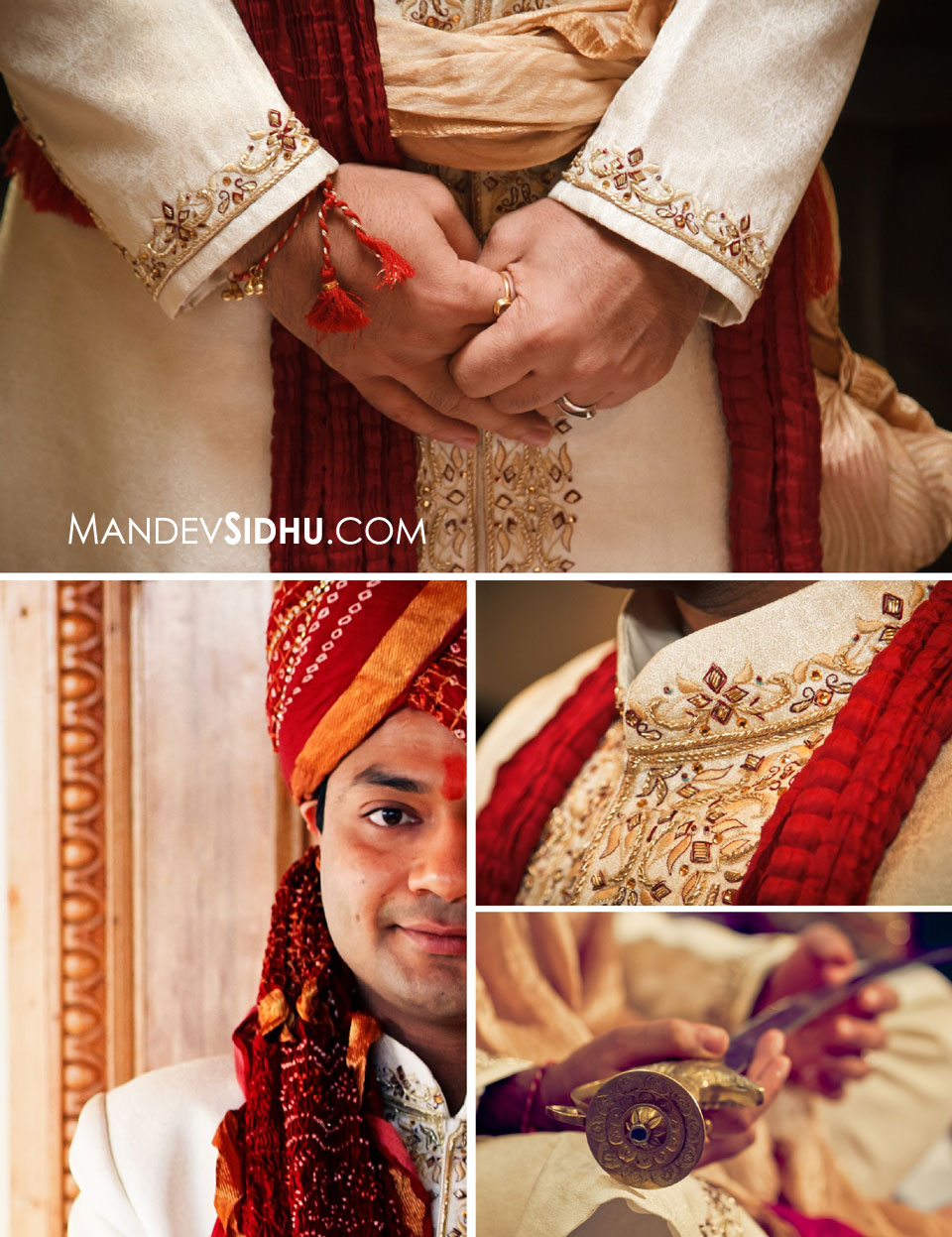 The music began in the prayer hall and the guests arrived, followed by Mayank, who sat in the front center. Runeet entered, followed by her closest relatives and sat next to Mayank. The beautiful ceremony began with prayers, followed by music and hymns.
The music began in the prayer hall and the guests arrived, followed by Mayank, who sat in the front center. Runeet entered, followed by her closest relatives and sat next to Mayank. The beautiful ceremony began with prayers, followed by music and hymns.

